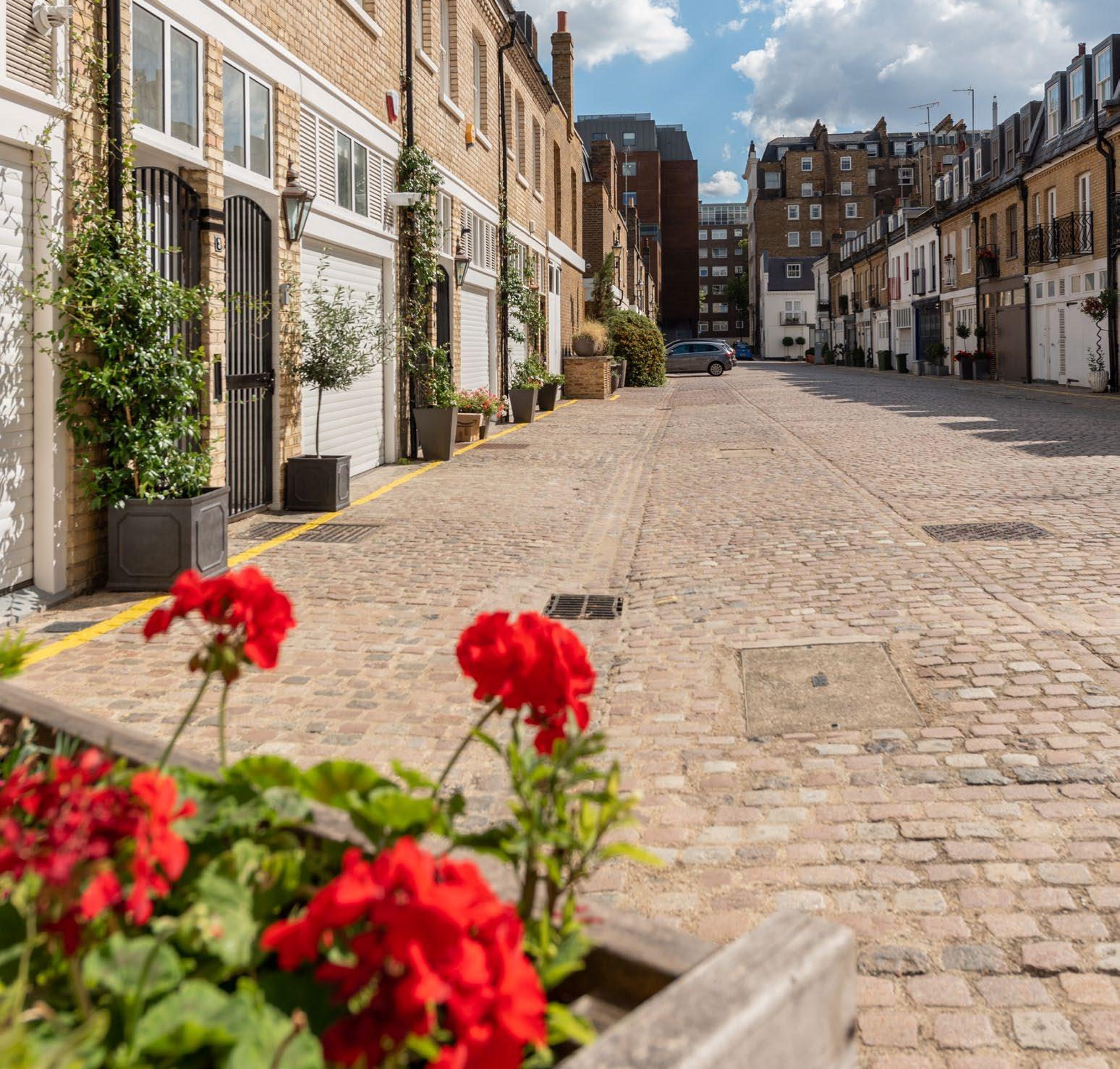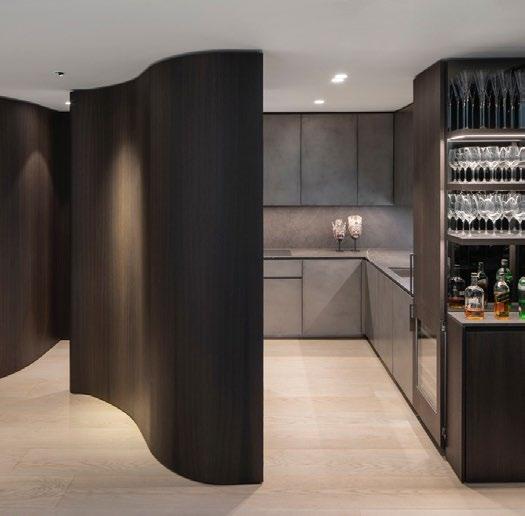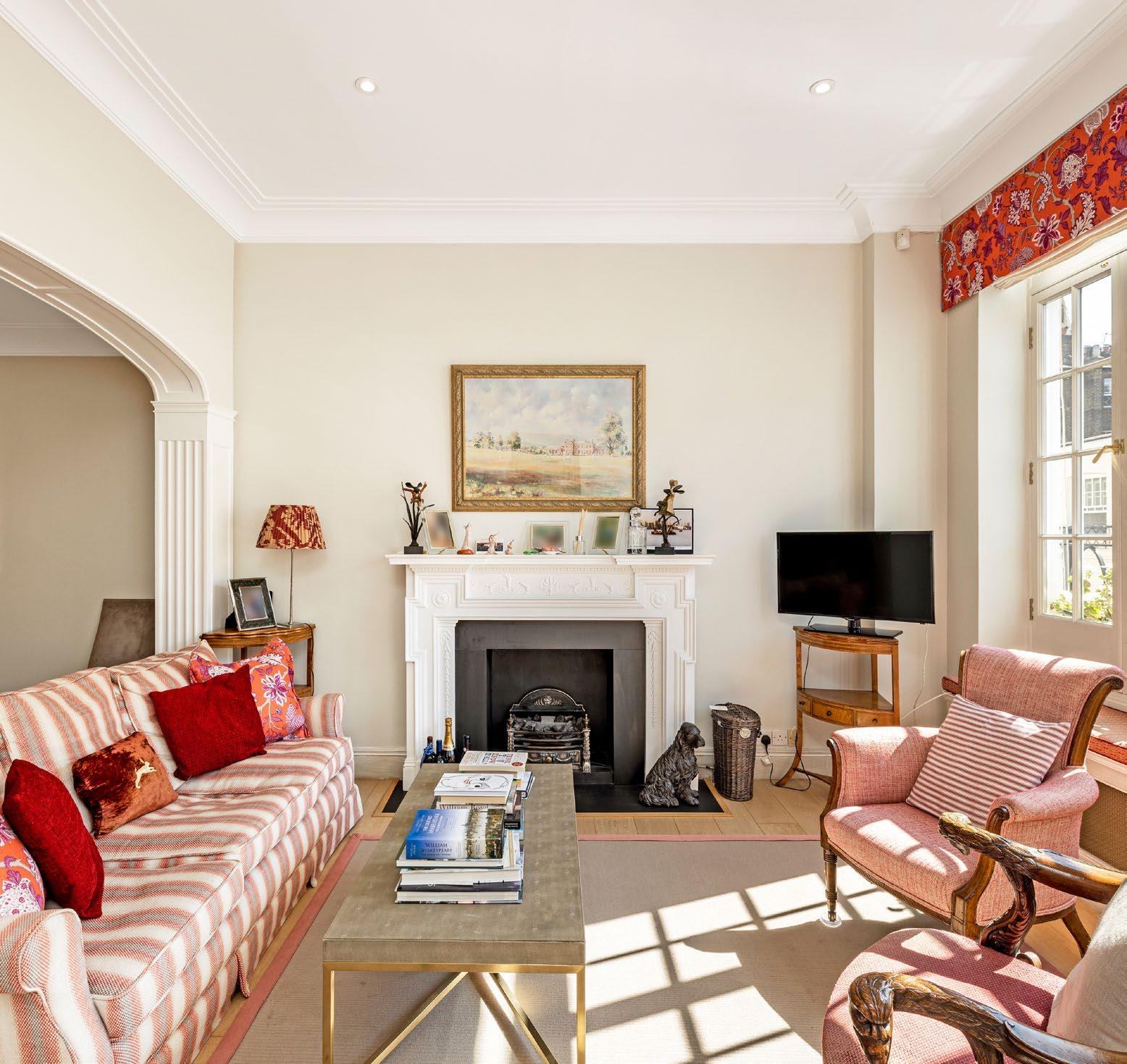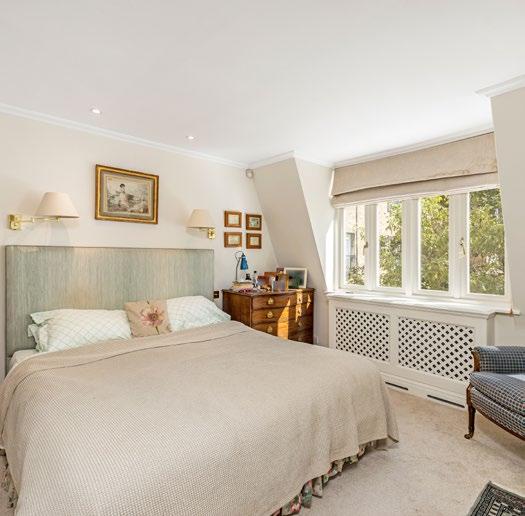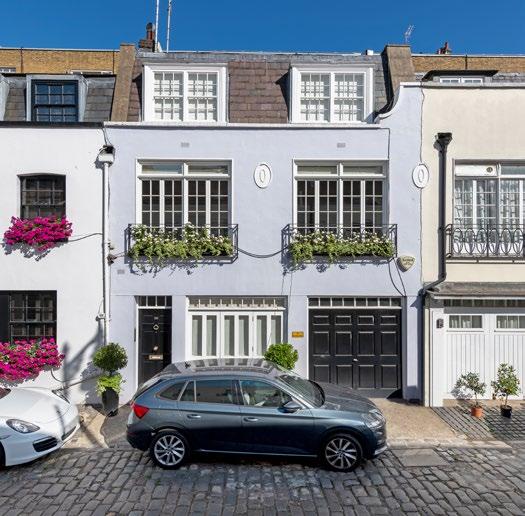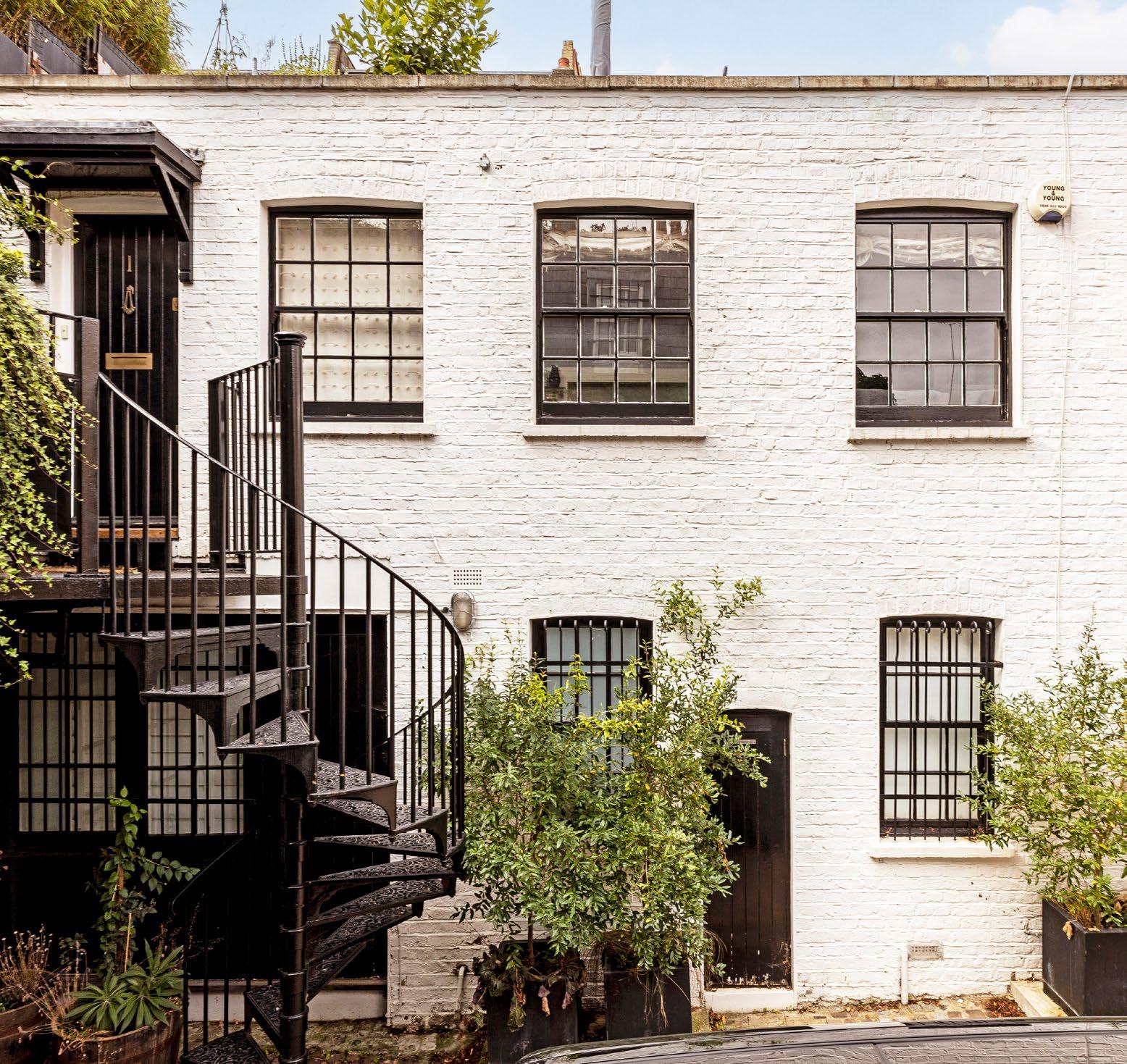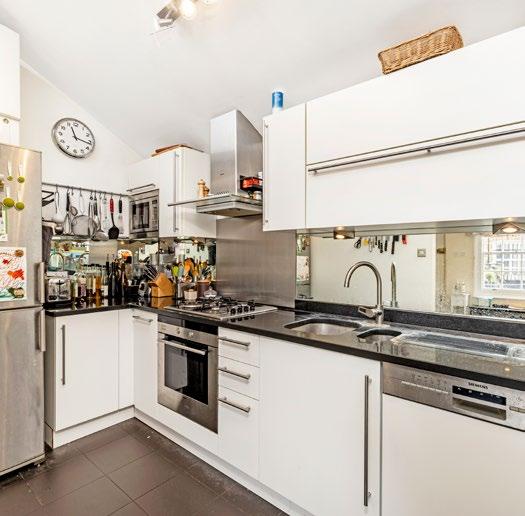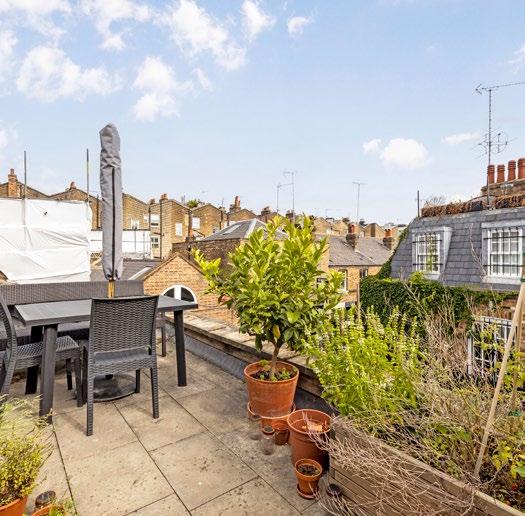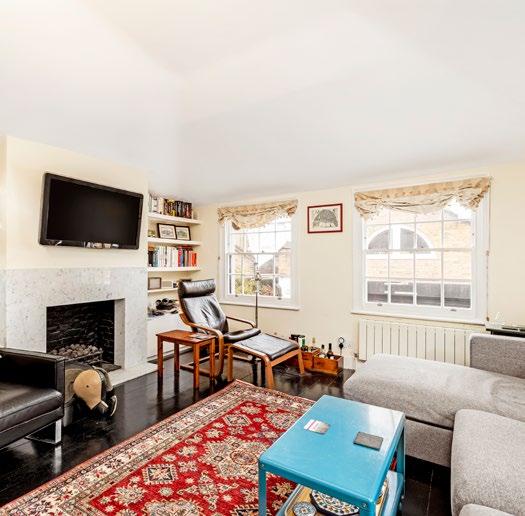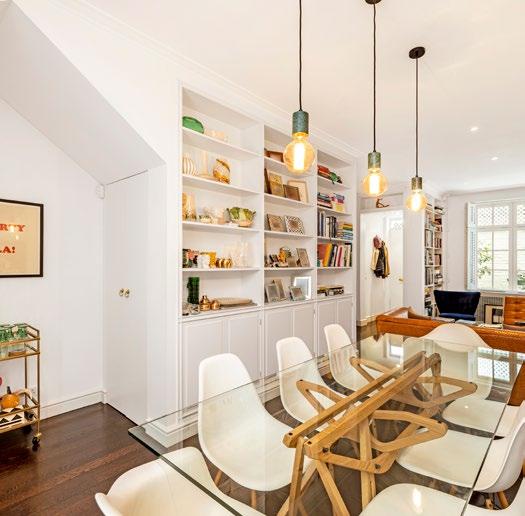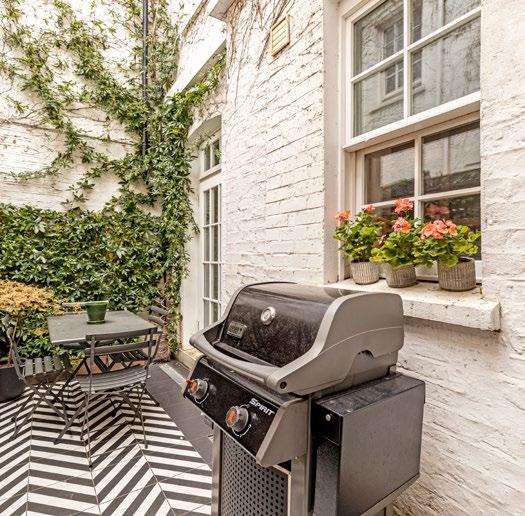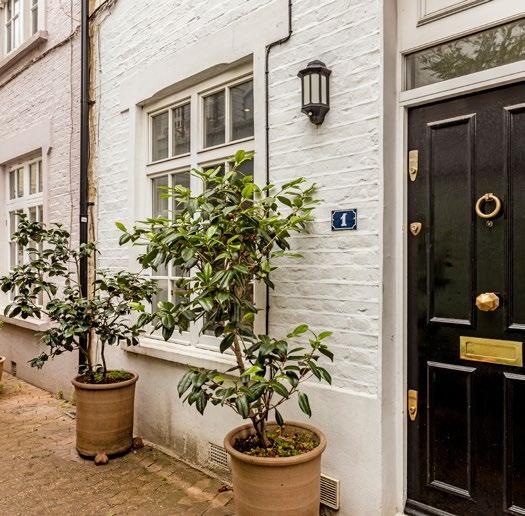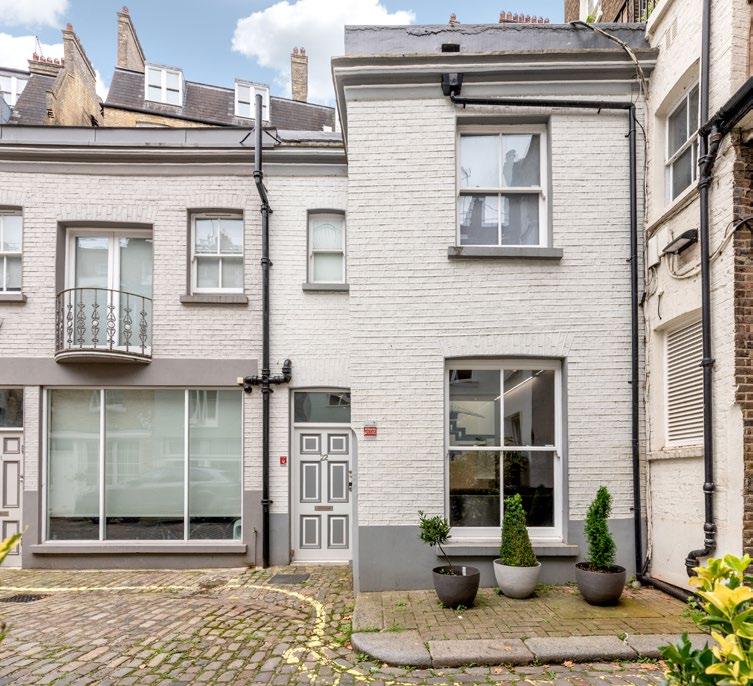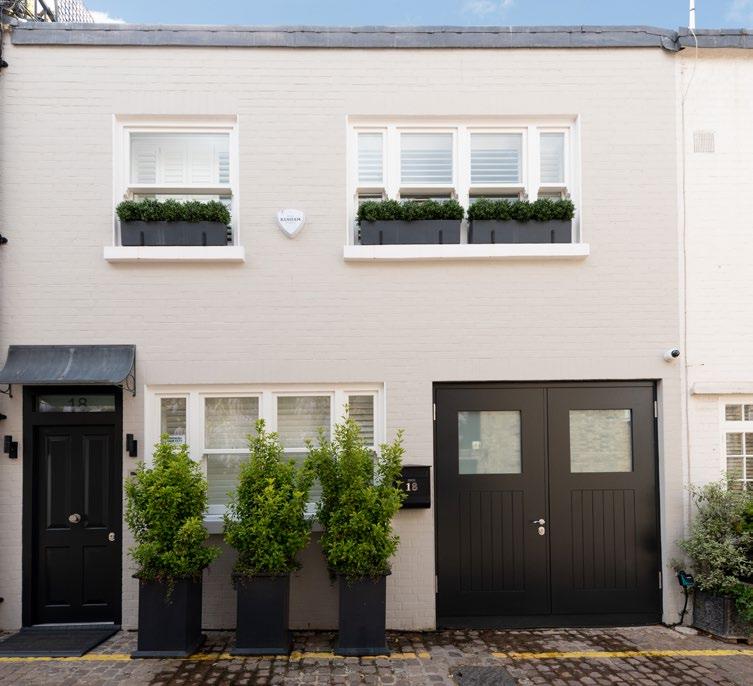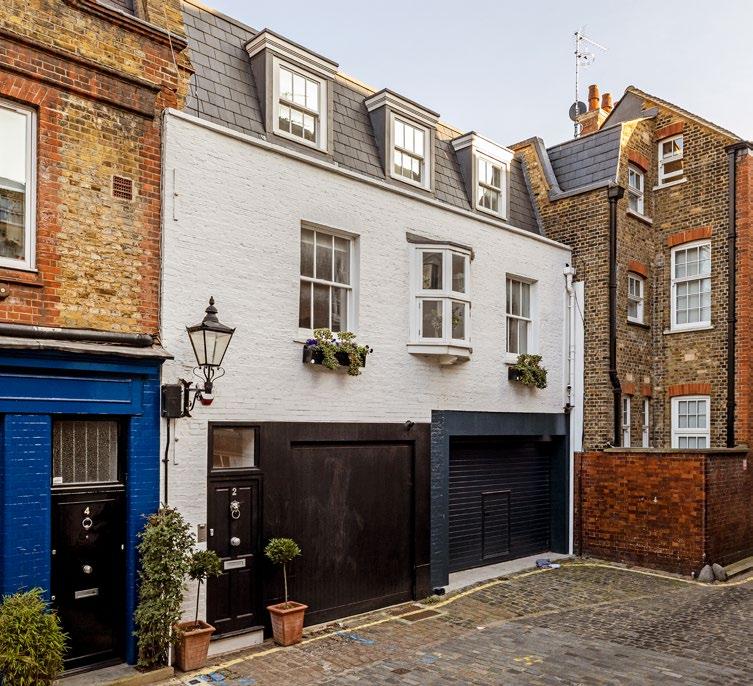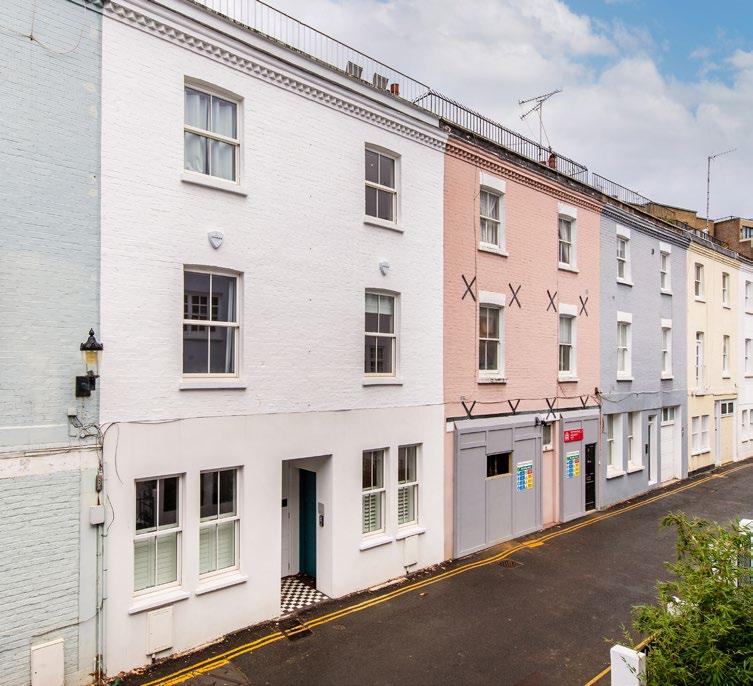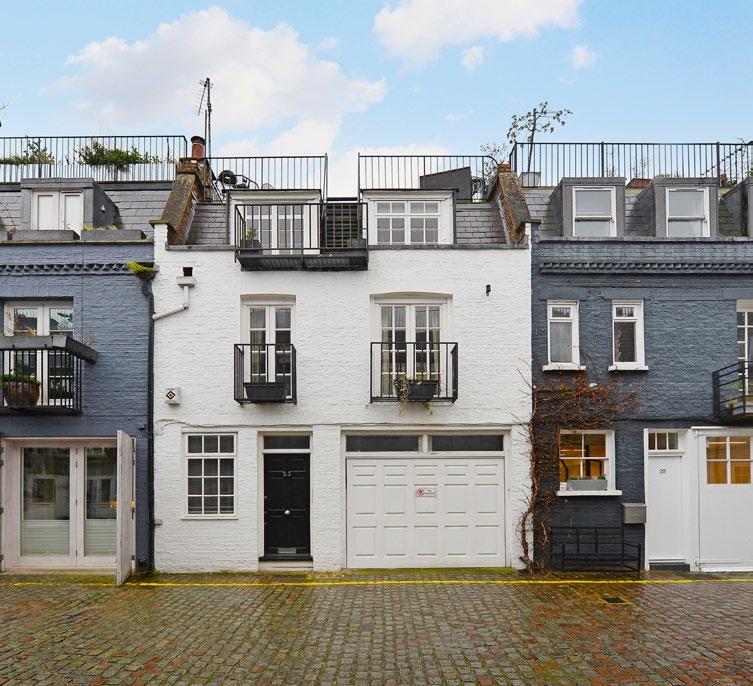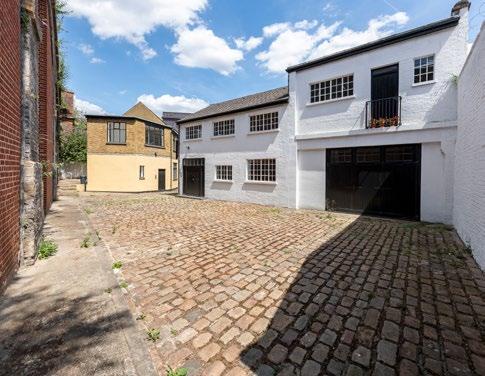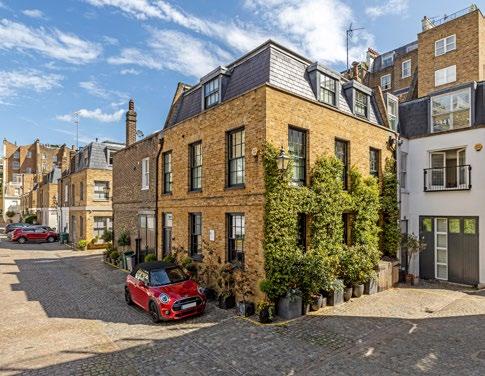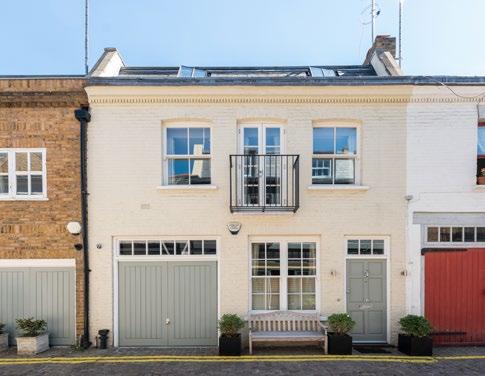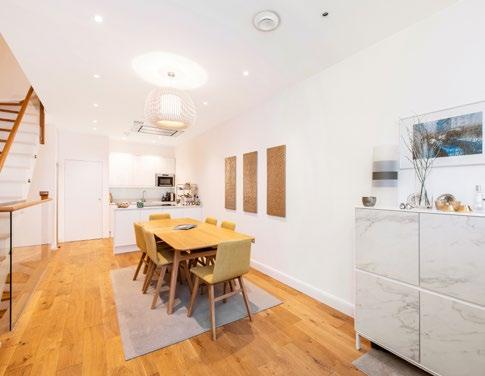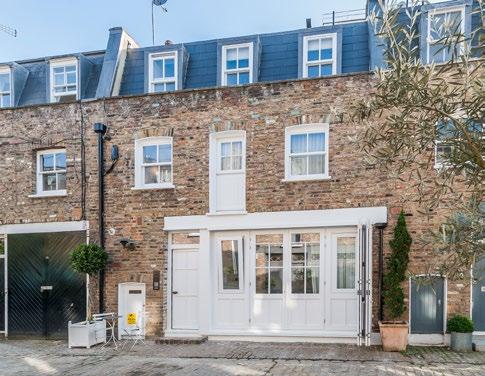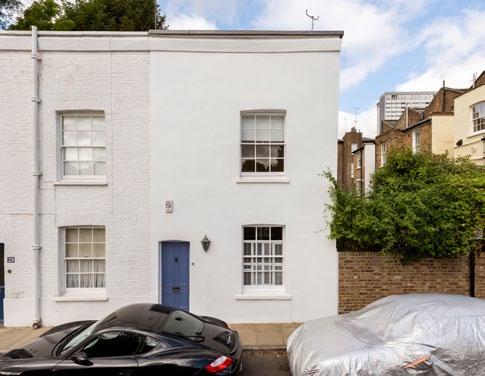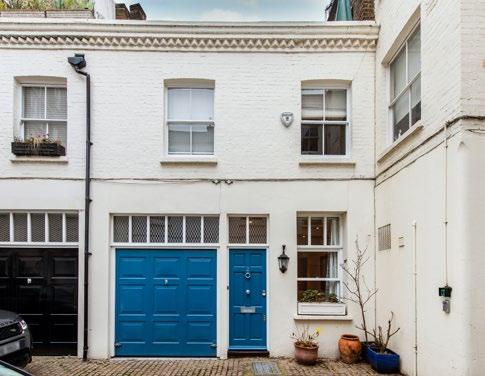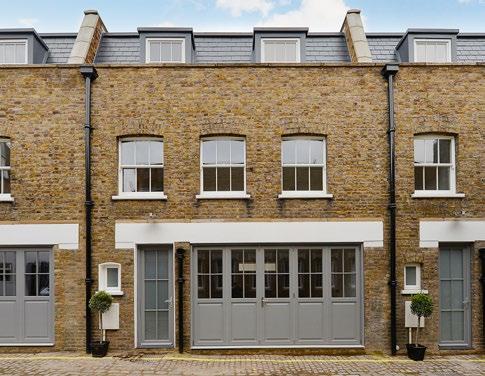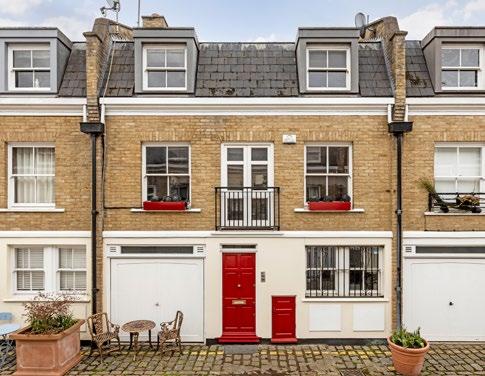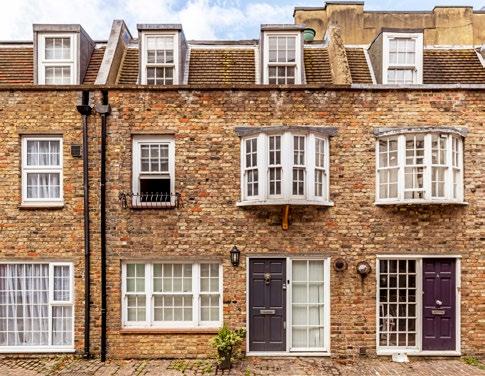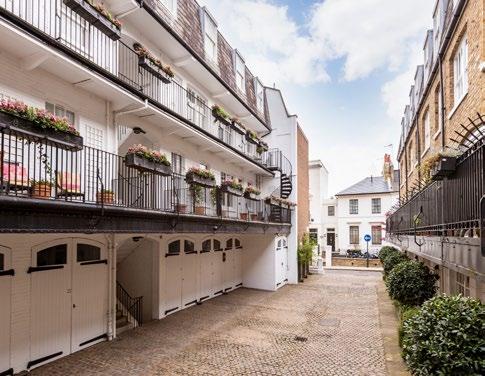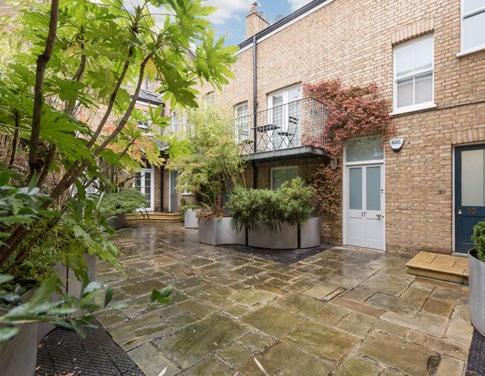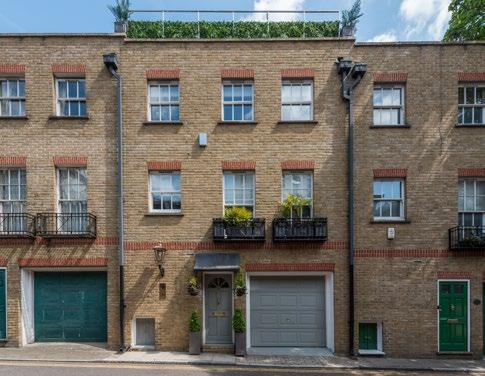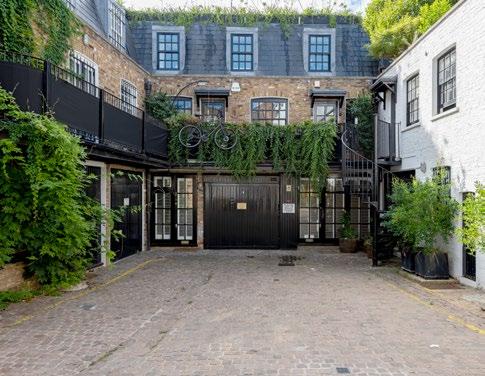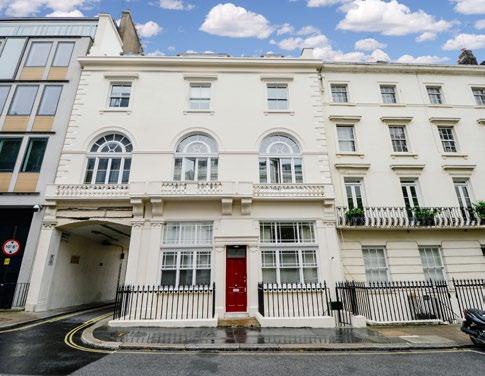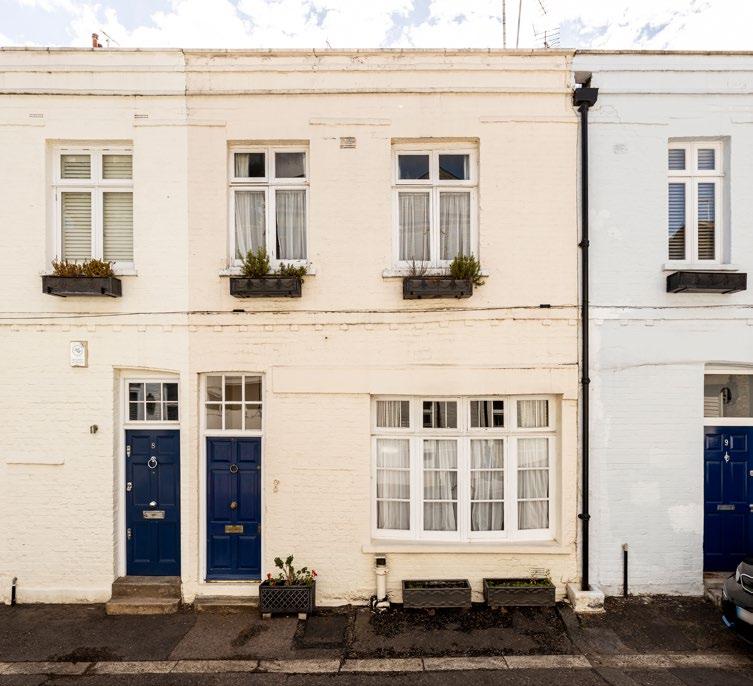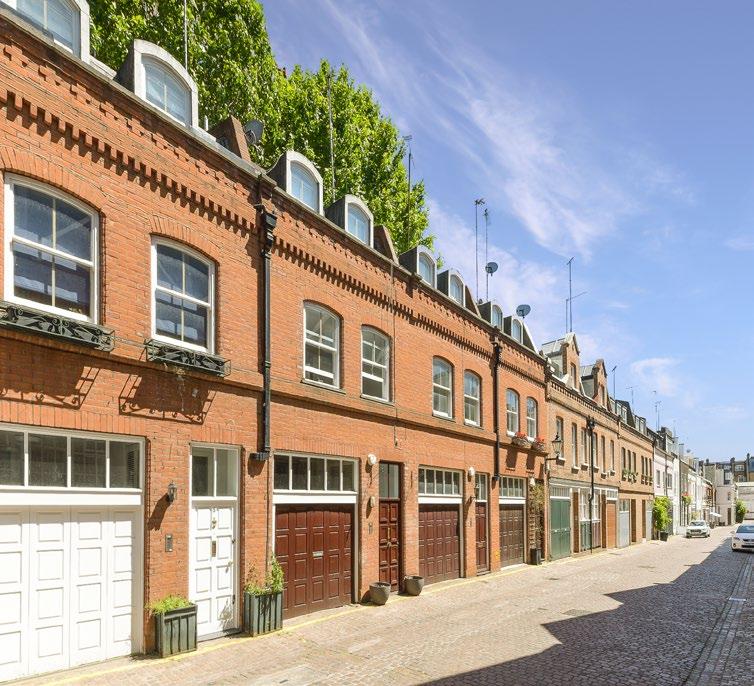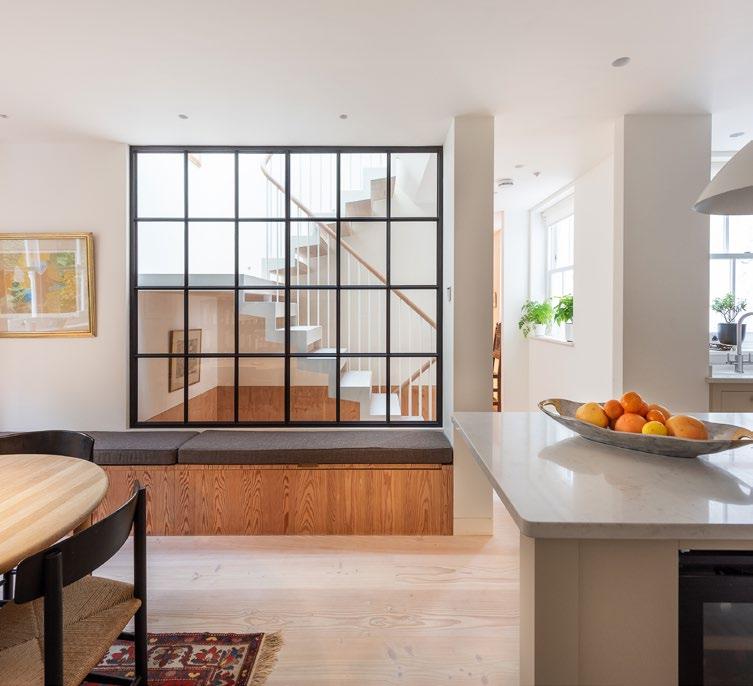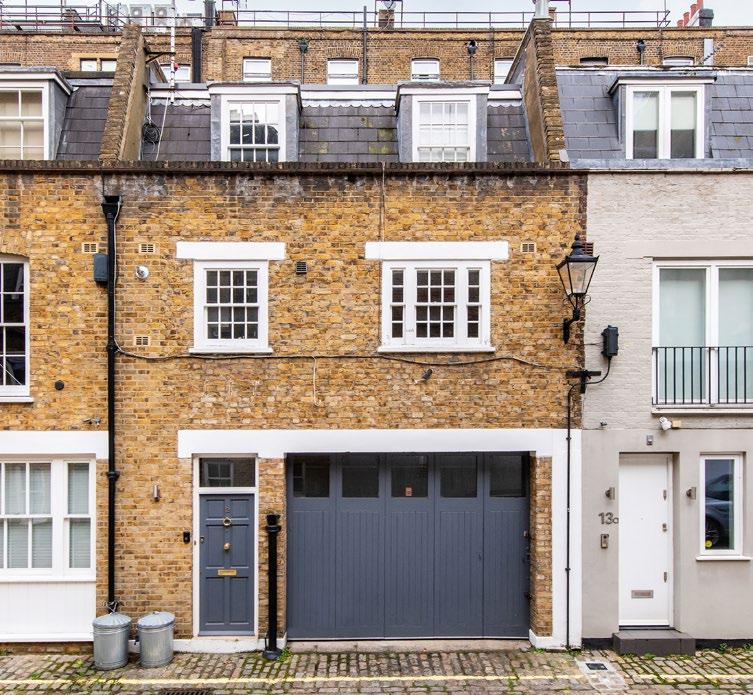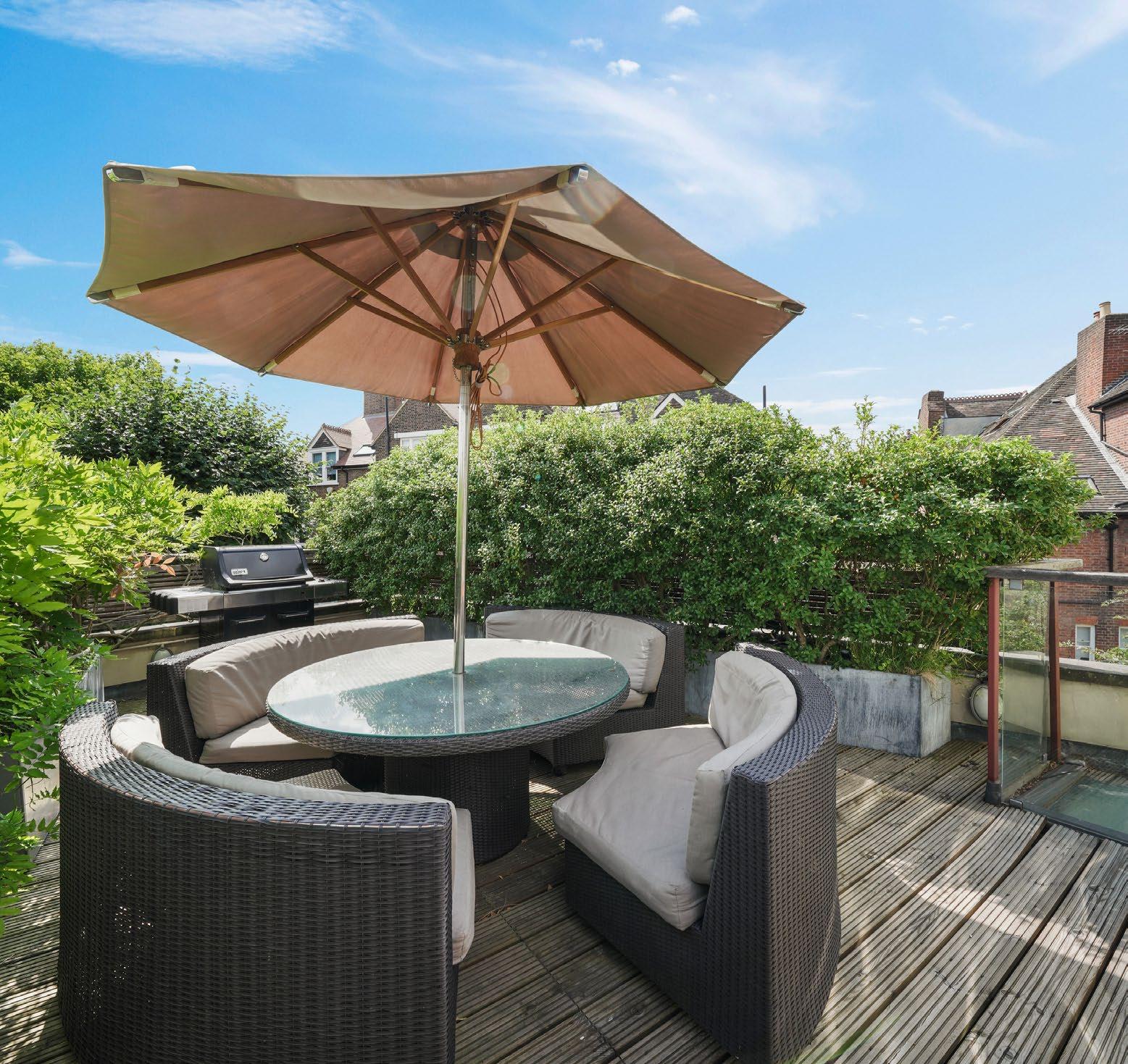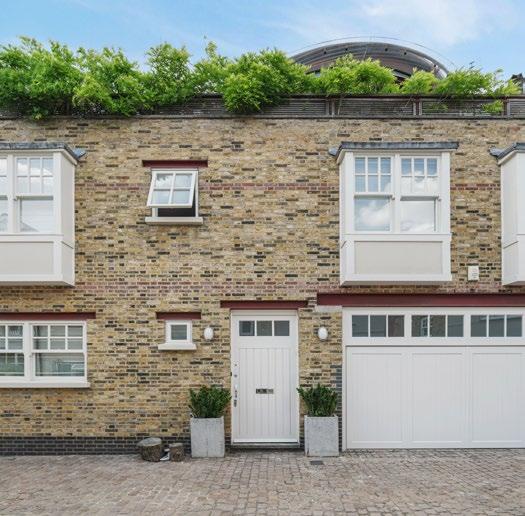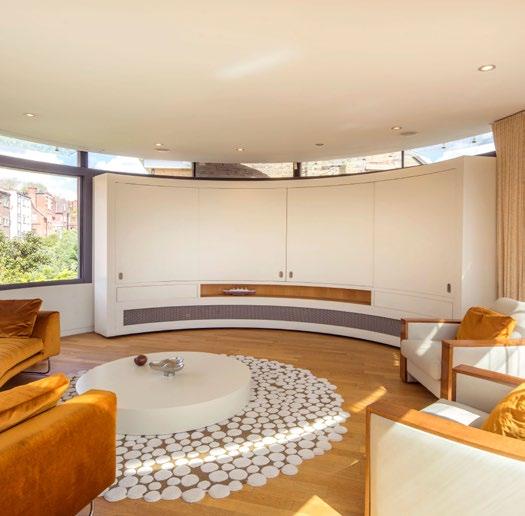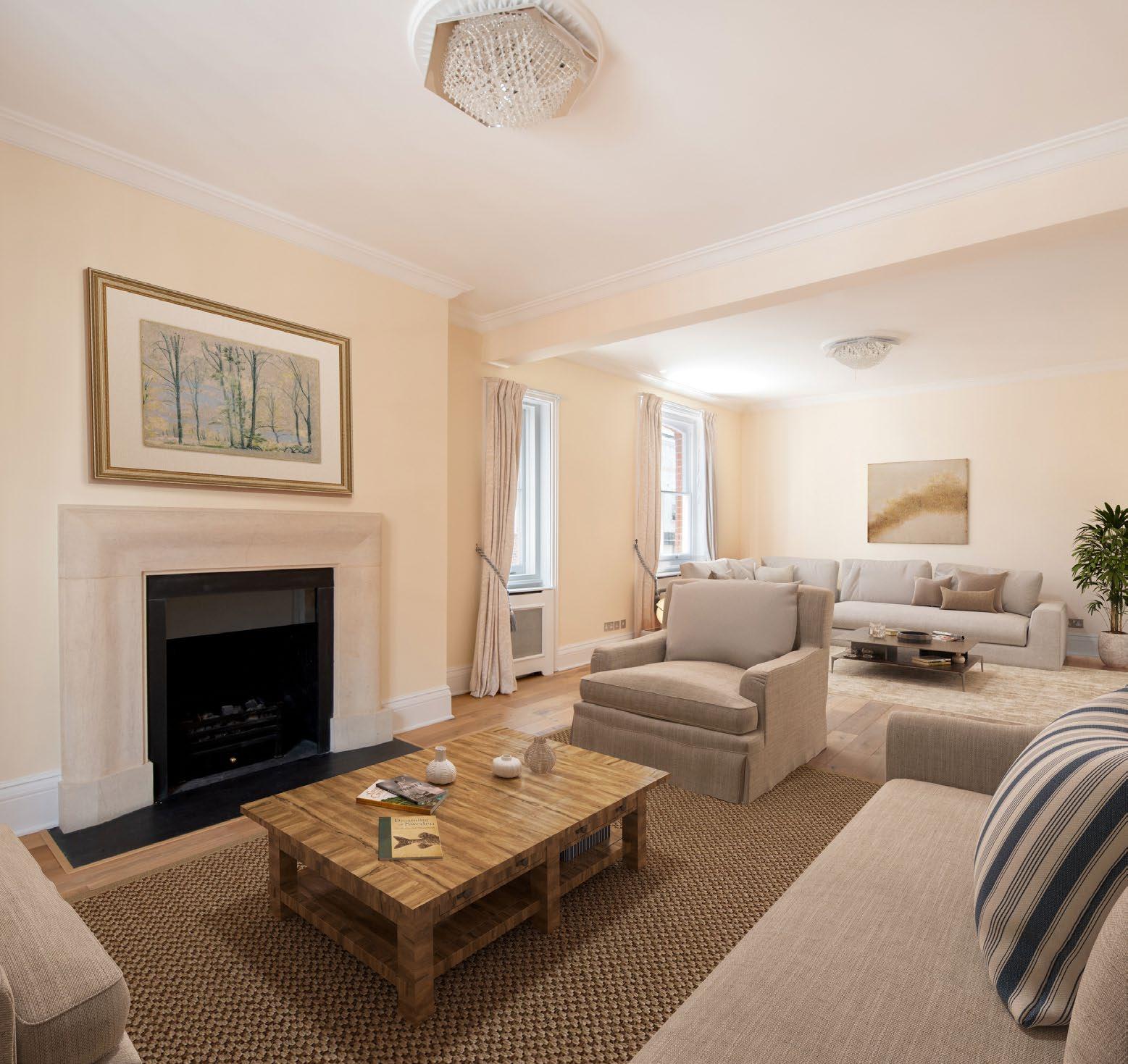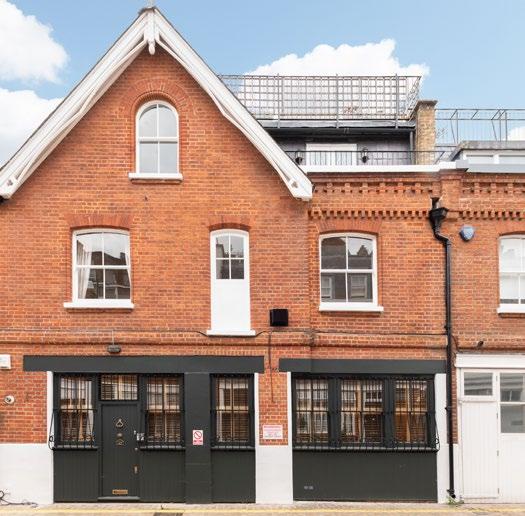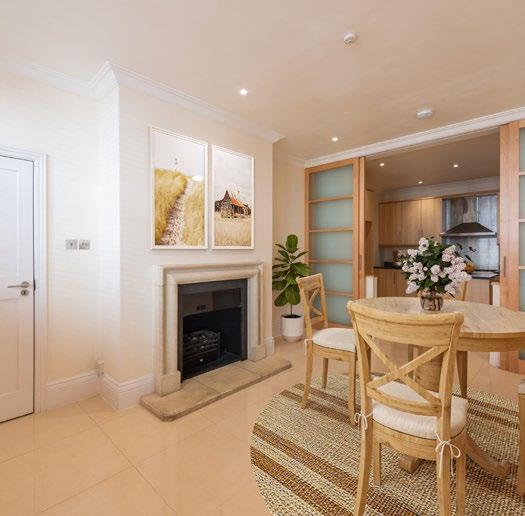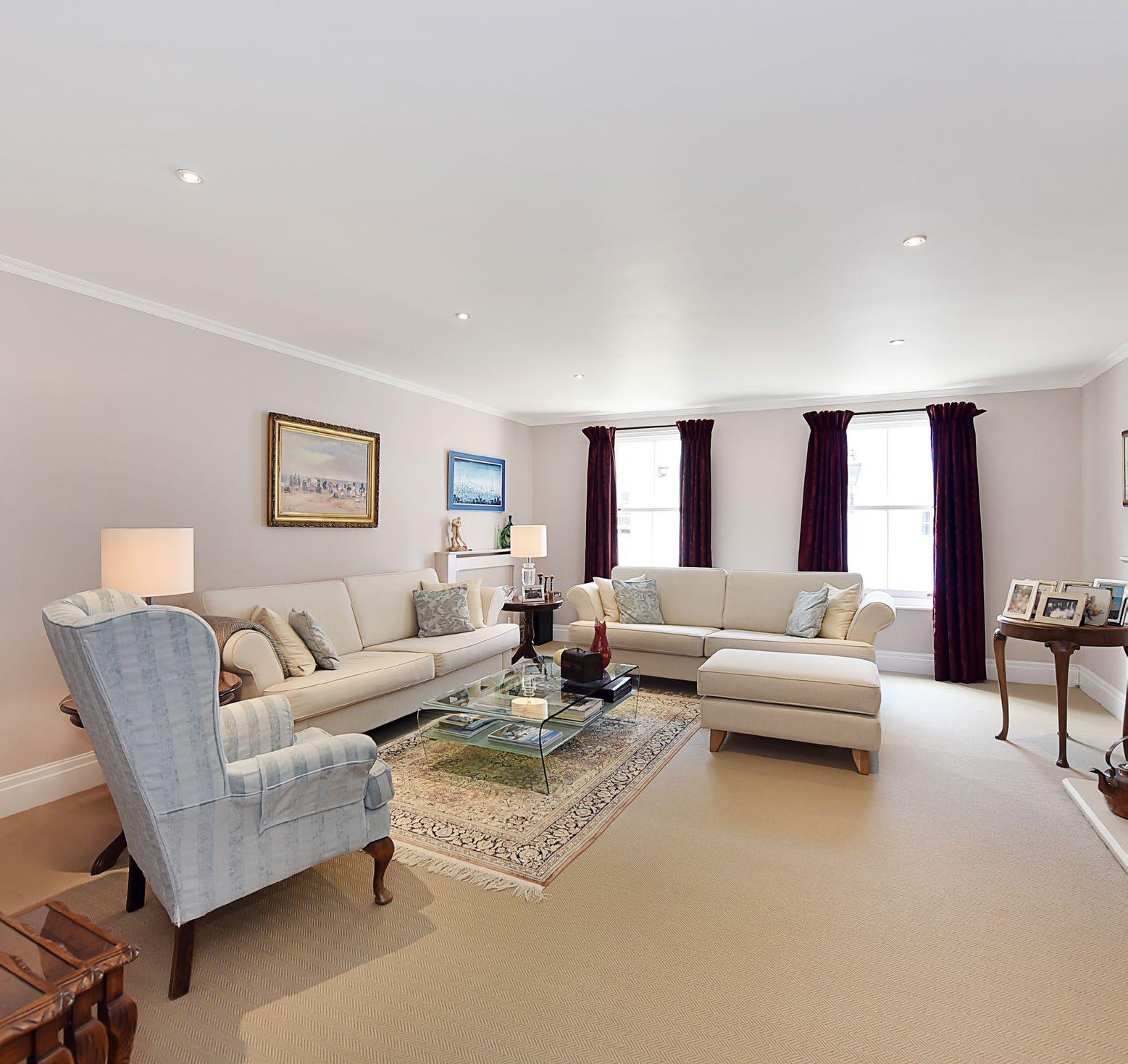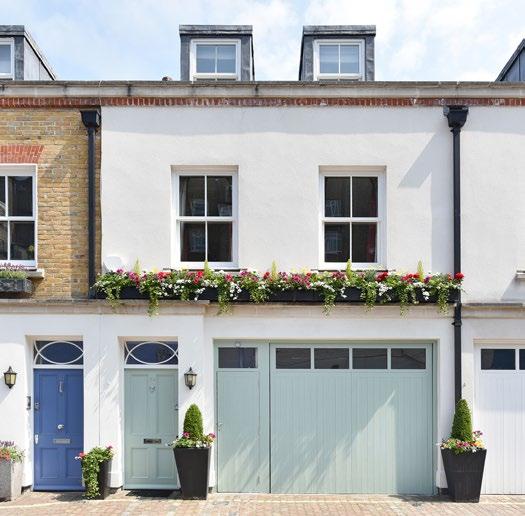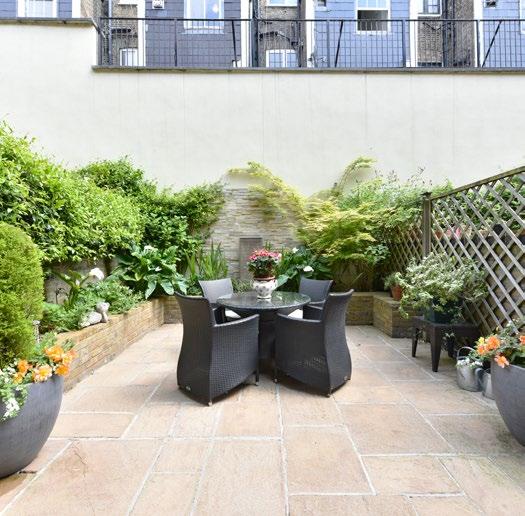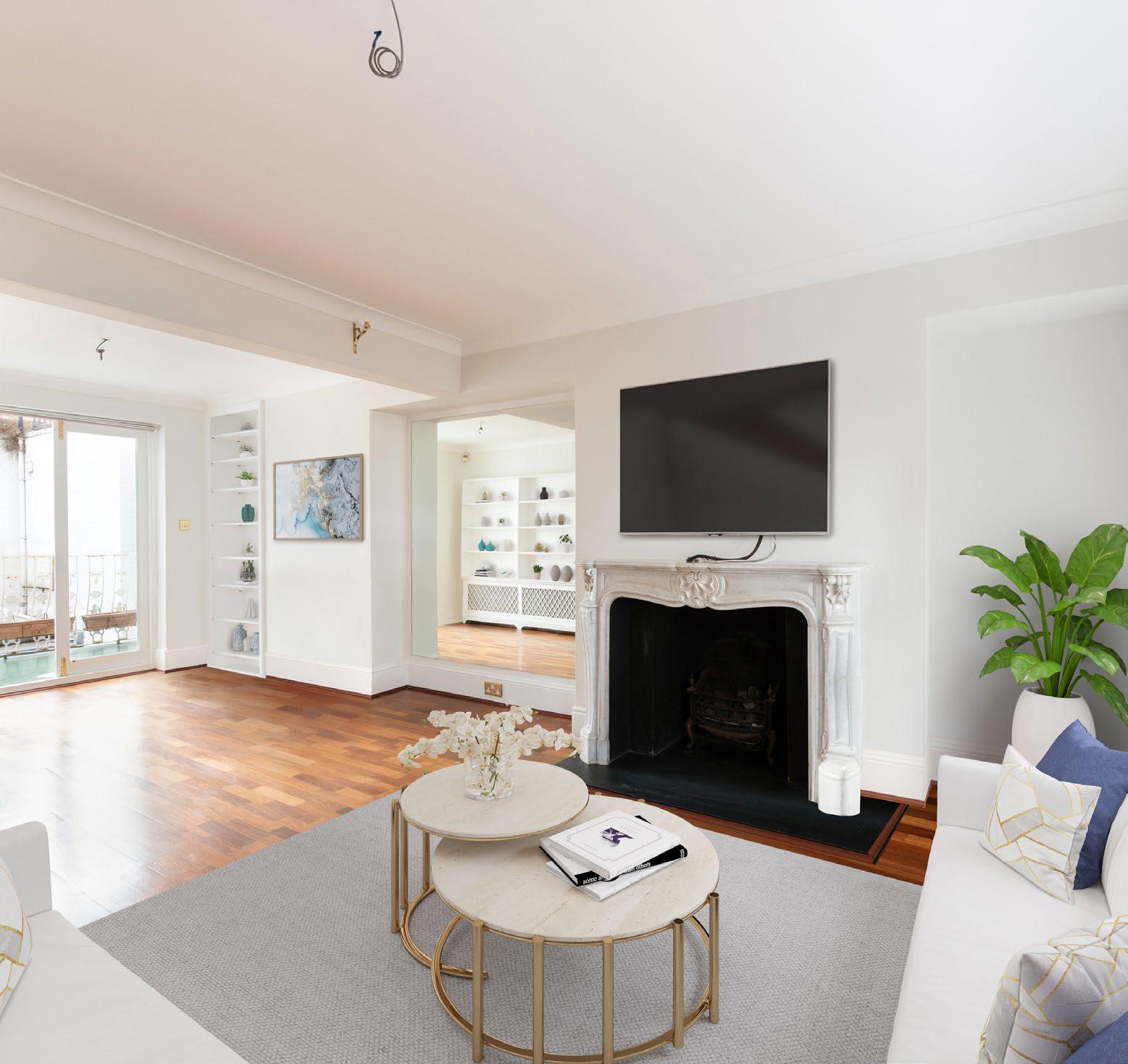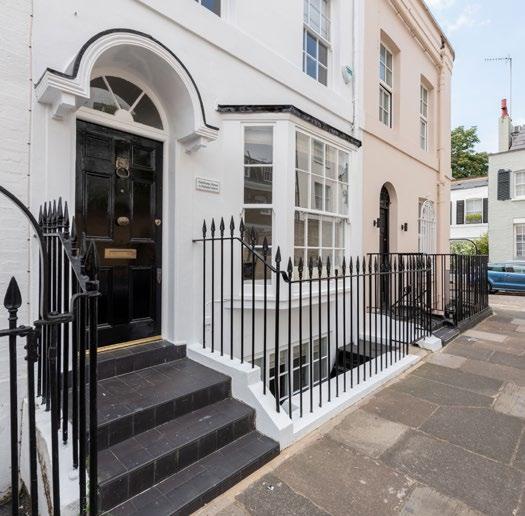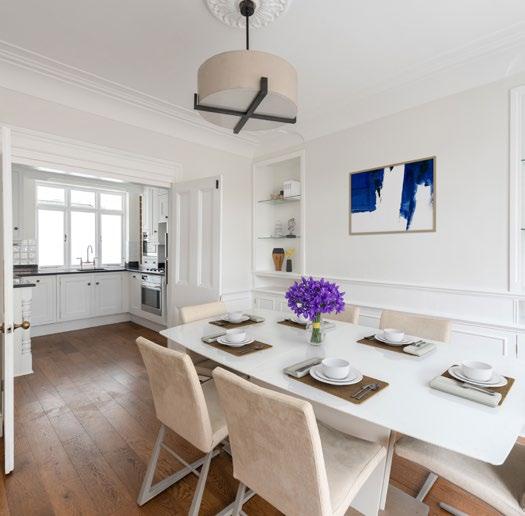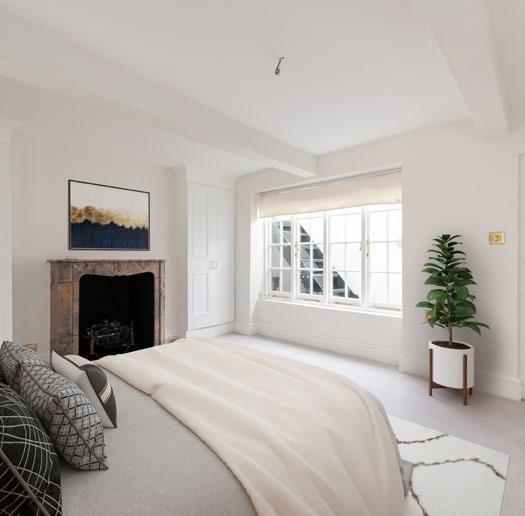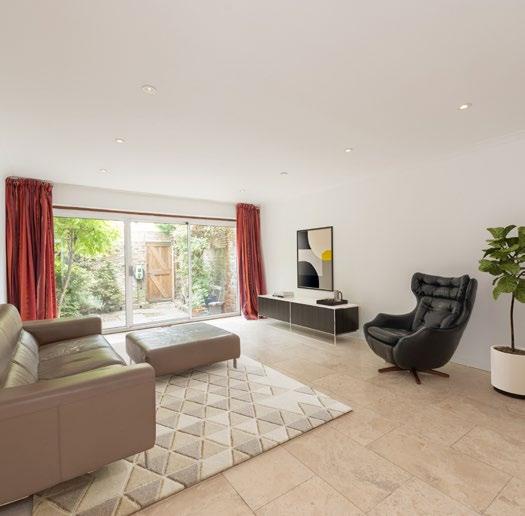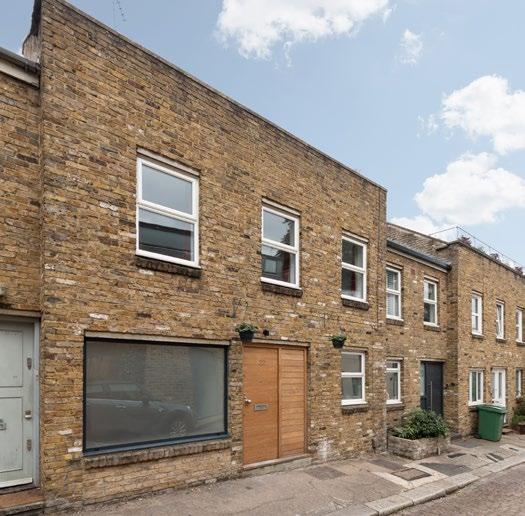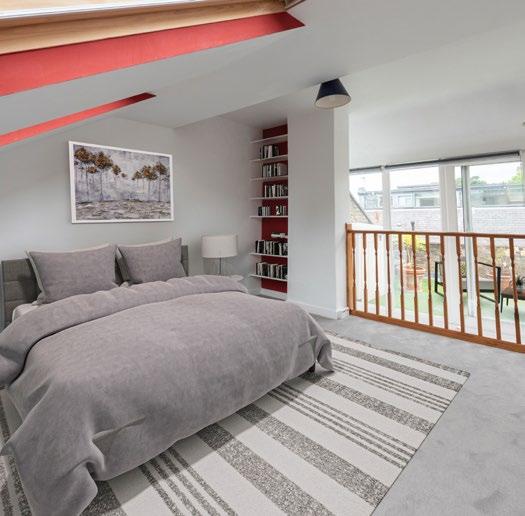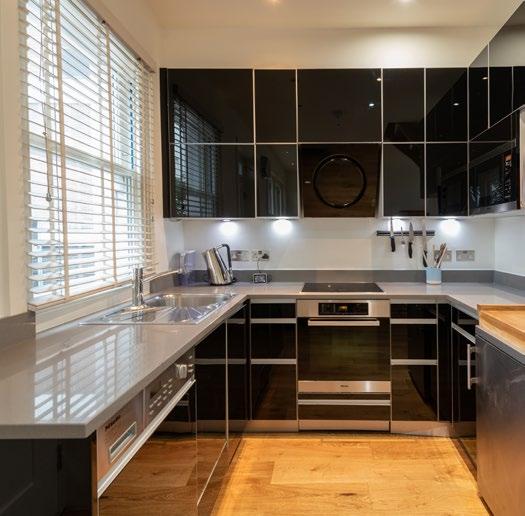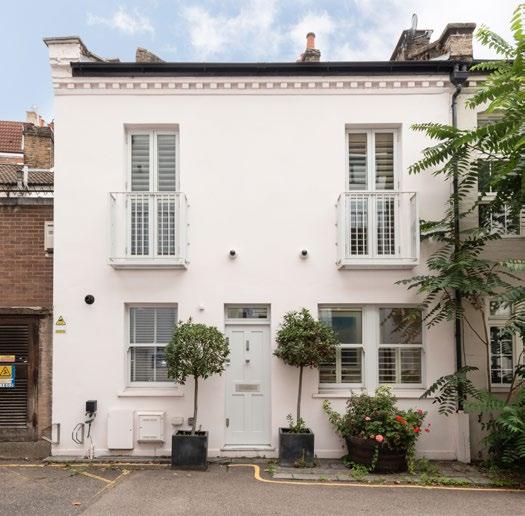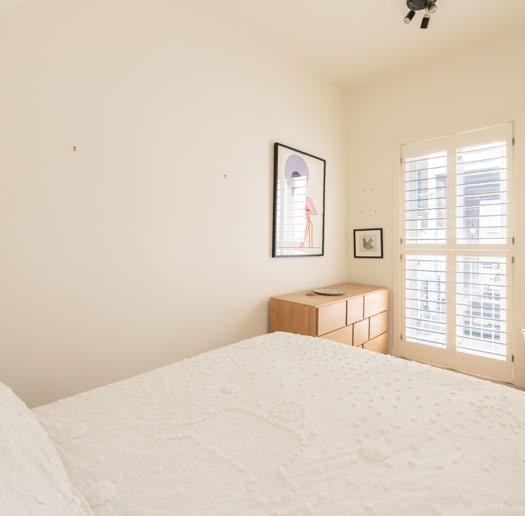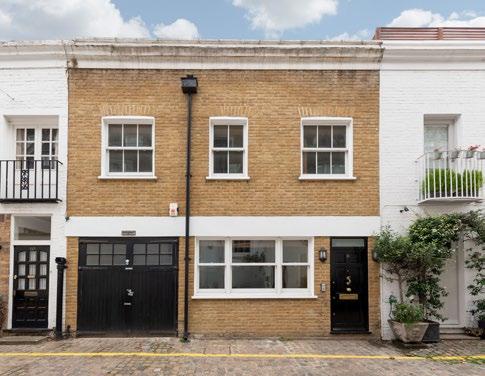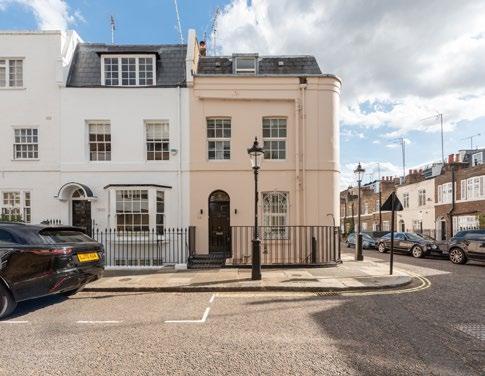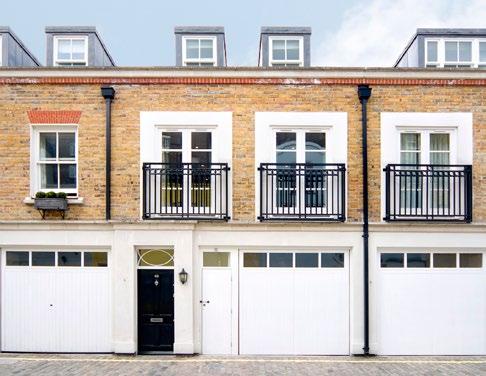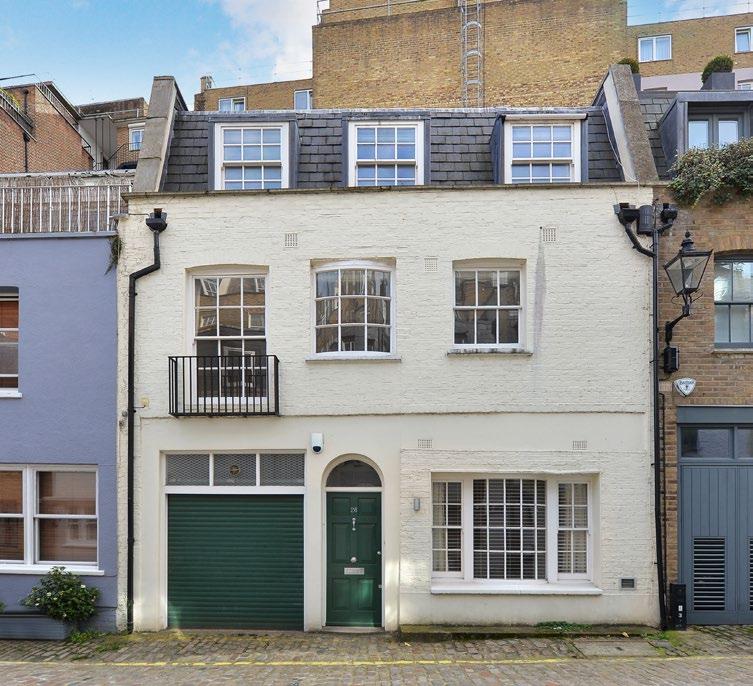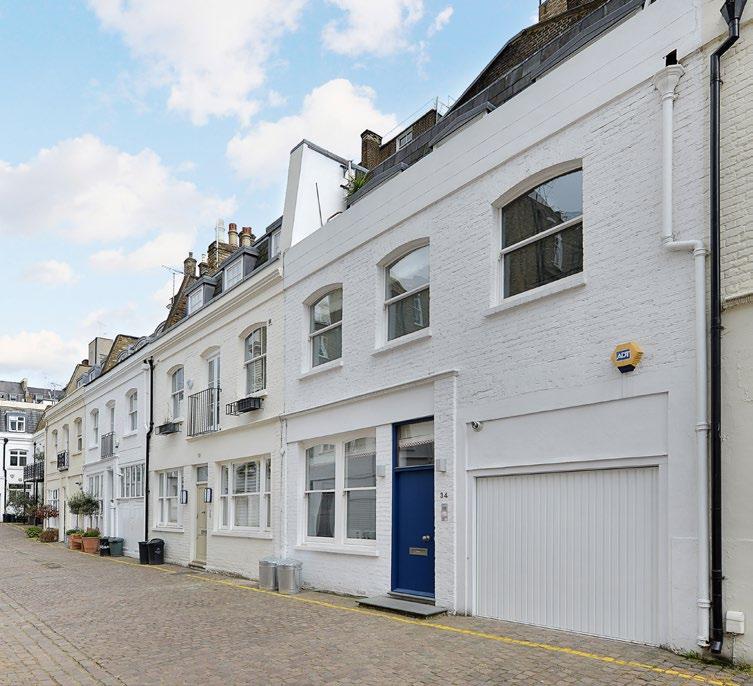
THE FIRST WORD IN MEWS






There’s a whiff of change in the air, not just as we enter into autumn, but now that we have a new monarch, a new Prime Minister, and economic challenges raining down on the entire country. That said, the business of house buying, landlords investing and people moving continues from one season to another. I find it astonishing to be introducing the autumn edition of Mews News when so many major and significant events have happened since the last summer issue was delivered to your door.
In the pages of this issue Antoine Lurot warns us about the Valuation Sirens. You can read about a stalwart of London pubs, Fuller Smith & Turner, from its Retail Director, Fred Turner, who walks us through its past, present & exciting future.
We love our pubs so much, that we have chosen to focus on them in LB Loves this time.
Martyn John Brown with his regular ‘Everchanging Mews’ article, pays homage to our dearly departed Queen Elizabeth II by delving into the mews’ royal associations, rich history and evolution into a modern home of choice within quiet cobbled London streets.
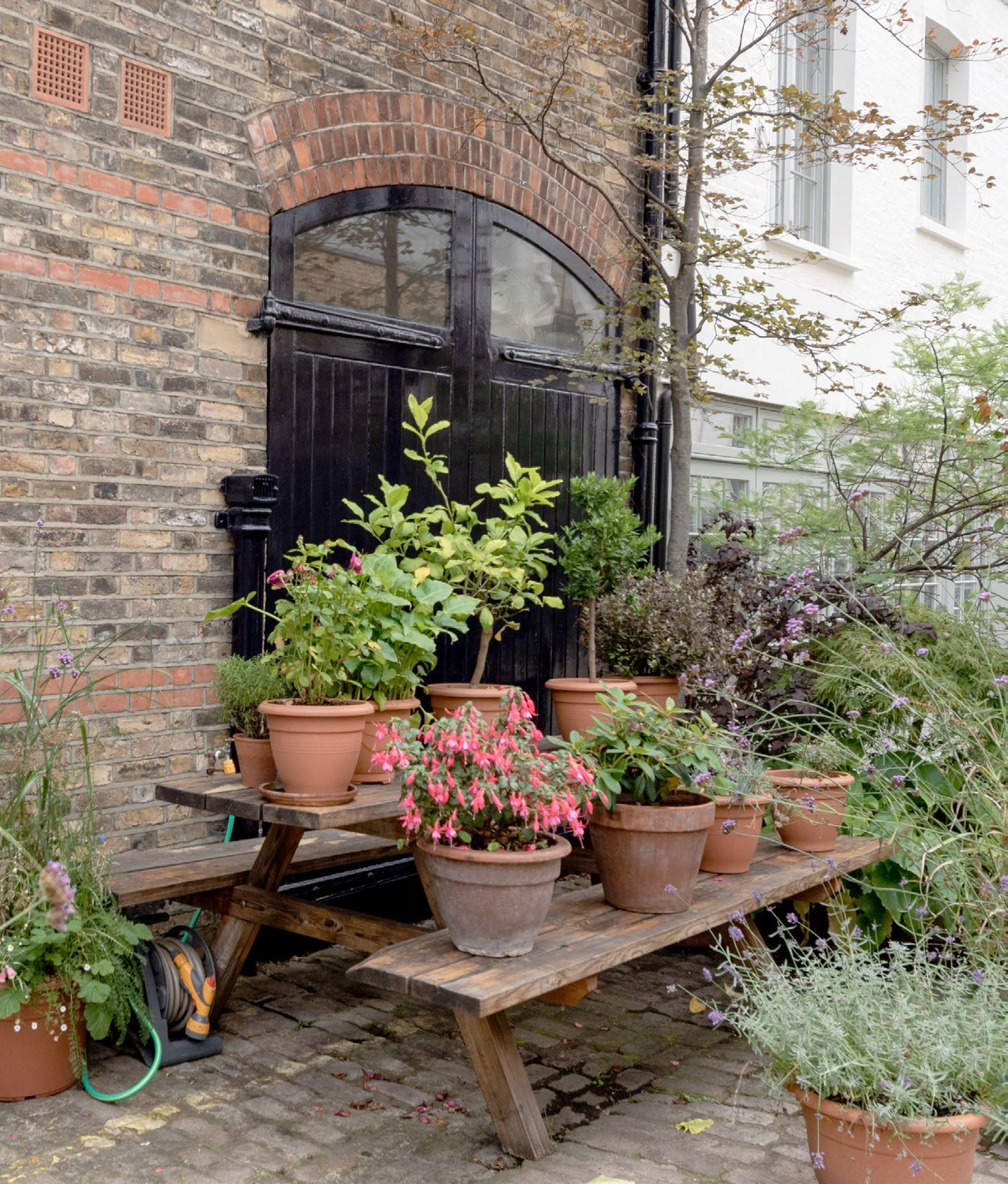
Property writer and journalist Zoe Dare Hall drills down on the state of the prime central London property market, the impact of a weak pound and the influx of American buyers, in an on-theground conversation with yours truly.
Something for everyone, and hopefully a good read as you turn on the heating, light the log burner and start reaching for casserole recipes now that autumn comes calling.
First coined in the Latin epic poem, the Aeneid, the phrase ‘timeo Danaos et dona ferentes’ means beware Greeks bearing gifts and relates to how the wooden horse was used to attack the Trojans
All too often sellers or landlords are seduced by the agent who plays to their desire to obtain an inflated value for their property. But, like the Trojan horse, the agent in question knows that they are often overpromising an unrealistic price. Having won the instruction, they then spend the ensuing weeks explaining to the disgruntled vendor why they aren’t achieving the price that’s been set. Eventually either the price, or agent, is dropped.
To avoid that, make sure that each agent that comes up with an enticing price can support their price with recent details of comparable sales. Of course, what the market will bear and the price a vendor may wish to ask can often differ. By all means, try your luck for six weeks at that price, either on or off market, but don’t leave it there any longer as you will be in danger of damaging
your property. We all like to believe that our property will be ‘hot’ and sell quickly but only once in my 50 years have I been fortunate enough to have a purchaser –affectionately known as Estuary John, a City worker, declare, ‘If I don’t have an ‘ouse, I don’t have a wife’. Money was no object – but sadly, he’s not typical.
Today, serious purchasers are typically very knowledgeable about the market and values at that moment in time. The internet has helped to ensure that properties are viewed and scrutinised in terms of comparable values, decorative suitability and perceived kerb appeal. It’s a rare purchaser that hasn’t done their research before they undertake physical viewings. So, they are very aware if a property has been on the market a while and it can lead to low offers as there’s a feeling that the seller might be having a problem. All this means that selecting the right agent is critical from the outset.

At this point it’s important to restate that ALL agents have a fiduciary duty to their client. It is bound in law that it is our duty to perform to the maximum for those that are paying us. But, to make a seller happy, we have to also make a purchaser happy.
SO, WHAT ROLE DOES A GOOD AGENT FULFIL FOR THEIR COMMISSION?


Firstly, they must fully appreciate the emotional and rational needs of both the vendor and the purchaser. They must then marry their motivations and desires to ensure that a sale is successful. Assessing long term personal aspirations may help to identify appropriateness of a property.
Secondly, a good agent will work with the seller to achieve the best price. That may mean delivering some hard truths which
wouldn’t be inappropriate for the recent incumbents at 10 Downing Street, ‘Dear client, your statement wallpaper is very striking and highly individual, but it will be difficult for many viewers to see past it to the potential that the property offers’. In other words, you might not like magnolia, but sometimes the blank canvas approach achieves higher values. Occasionally we must advise, ‘Your collection of Toby jugs is extremely jolly, but covering every available surface may make it difficult for a viewer to visualise themselves in this property.’ Less is more, particularly in mews homes and you need the honesty of that approach from an agent. Reverse psychology can also come in to play when we advise a purchaser that a property ‘needs work’. That may horrify the vendor but it often excites a purchaser and their response is often ‘Mr Agent, it’s not as bad as you said’.
Many larger estate agencies sell the benefits of their international office network. Internet portals mean that all firms now have a global reach and boasting international offices is a red herring when it comes to mews properties. Why? Well, mews homes typically appeal to a UK, US, Australian and Western European demographic. Other nationalities tend to prefer lateral living often in more modern blocks. It’s all about knowing your market, talking to them regularly and having a strong database of qualified serious potential purchasers who ‘get’ mews homes and the sort of lifestyle living in a mews offers.

It’s vital to cultivate the relationships with buyers because it is then that we can help drive the best price for the seller. Sometimes our greatest successes have been when we’ve interpreted a purchaser’s wishes correctly but relocated them in an area they would never have considered.
Ensuring that we are helping buyers to navigate the complex web of solicitors, lenders, valuers and surveyors is all part of delivering for our vendors. A good agent will smooth the whole process and navigate both parties to a happy conclusion.
What they would be fired for doing at Lurot Brand is showing someone round, opening the bathroom door and declaring ‘here’s the bathroom’. Our sellers and our buyers are intelligent individuals who expect the agent to add real value. The added value that we expect to deliver is not stating the obvious but offering insight into mews living; explaining the way in which mews homes can be developed – or not – depending on their size and location and if the property is being viewed as an investment, where we would provide some real-time knowledge about rental values.
As the economic climate becomes more challenging there will still be a need for homes to be bought, sold and let. Agents will need to provide real insight and expertise to help what will inevitably be a nervous and fractious market. Of course I am biased, but I believe that when times get tough, that’s when the tough really get going and the specialists who have real knowledge and insight will win out over the generalists. In short, and if you’ll excuse the mixed metaphor, before appointing an agent, beat the Trojan horse as if it was a piñata and ensure that they will truly have your best interests at heart.
When all is said and done, it’s all about making the best use of your estate agent.BY ZOE DARE HALL
Property Freelance Journalist of the Year 2021, International Property Journalist of the Year 2021, Lifestyle & Interiors Journalist of the Year 2021 (Property Press Awards)

If ever there were a moment that epitomised the unnerving sense of flux we feel right now, it’s the 48 hours in September that saw the arrival of a new Prime Minister closely followed by the sad passing of our treasured Queen Elizabeth II.
Just a few months ago, one of the most immortalised scenes during the Platinum Jubilee and most fondly remembered is the magnificent moment when, over tea with Paddington Bear, Her Majesty’s eyes twinkled as she extracted a marmalade sandwich from her handbag. A final image that we will forever associate with the end of the reign of the country’s longest-ever serving monarch.
With a new PM, a new King and a currency in freefall, it’s time again for seismic change. But in London’s property market, such uncertainty is good news for some.
Within a fortnight, however, even those memories had been eclipsed by the shock tax cuts announced by the new Chancellor, Kwasi Kwarteng, which instantly lead to the pound plunging to near parity with the dollar and euro.
It’s a time of momentous change. For many would-be buyers and sellers in the London housing market, it feels like the latest in a long line of reasons to clamber right back onto the fence, which they have found to be a secure, if not particularly comfortable, perch over the last few years. Stamp duty rises and falls, Brexit, global pandemic, the war in Ukraine, economic shocks… how we all wish for things to be, and feel, reassuringly uneventful again.

“Impending financial recession and severe inflation are making people say ‘hang on, let’s see what’s happening’,” comments Marlon Lloyd Malcolm, Sales Director at Lurot Brand. This summer, he adds, was the quietest he can remember, “for enquiries, viewings, offers, everything.” Part of the reason, he suspects, is the desire among Londoners to escape abroad after two years of holidaying at home, and they were leaving the phone at home - the old attitude of calling from the beach has gone out of the window.
Agents’ inboxes started to fill up again after the summer lull. Once schools re-open their gates, many parents step up a gear, acting on new ambitions and resolutions that make early September, rather than January 1st, feel like the real start of a new year. “Even though families aren’t our demographic, we deal with people who are still influenced by the start of the school year – often because they have children whose own kids have gone back to school,” says Lloyd Malcolm. “Their attitude to booking property viewings has changed; they are no longer booking for next week. Now they are calling to say they are in London this morning and requesting to view a certain property at 12. There’s a sense of urgency.”
For some, flux is a wonderful thing. Hello, all you Americans out there, who are now getting the best exchange rate ever. Prime London estate agents are reporting US buyers pitching up with big budgets –tens of millions, in some cases – to spend, purely because of the exchange rate. “The currency shift means that dollar buyers no longer have to factor in the stamp duty as that extra cost has been absorbed by the
currency rate swinging so dramatically in their favour,” says Lloyd Malcolm of the deterrent that has stood in the way of buyers since the first SDLT changes in 2014.
All of a sudden, he finds himself regularly explaining the nuances of ‘freehold’ and ‘leasehold’ to the American buyers who stroll into his office, looking to diversify their property portfolios this side of the pond. For while London’s history, cultural heritage and liberal environment – politically, and lifestyle-wise – chime with many American buyers, the complexities and limitations of leasehold property makes little sense to those from anywhere other than New York, says Lloyd Malcolm. And for all buyers, wherever they are from, this era of rocketing living costs and energy prices makes freehold property a more reassuring proposition than ever. “With a freehold house, you don’t have the worry of outgoings rising out of your
control. You can control the bills and improve your property’s insulation and energy performance,” he says.
The new stamp duty cuts that came into force on September 23rd – increasing the threshold at which first time buyers pay SDLT from £300,000 to £425,000 (and from £125,000 to £250,000 for all other buyers) – may provide a further incentive to invest in London property. But, while at the high end of the market, this SDLT saving is “nice to have,” says Lloyd Malcolm, “it doesn’t touch the sides. It amounts to a saving of around £2,500 for buyers in the upper brackets, and the ramifications of this stamp duty cut – the devaluation of the pound, the predicted inflation rises – won’t be to anyone’s benefit.”
Many buyers don’t need stamp duty cuts in any case to persuade them to invest here. These may feel like chaotic times to us, but it’s all relative. To buyers from elsewhere

in the world, London is still a beacon of stability. “We’re seeing sophisticated investors who have made their money out of the investment markets now terrified of keeping their money in them,” says Lloyd Malcolm. “With bricks and mortar, they know what they are getting and while it may have its ups and downs, the constant need for an asset that is also a shelter is reassuring.”
Inflationary times have also historically been good for London’s property market, with property considered a good hedge against inflation, and effectively a bonus for anyone with a long-term, fixed rate mortgage. “For argument’s sake, if the interest rate is 3% and inflation is 10%, you have a net gain of 7% on fixed rate debt raised,” Lloyd Malcolm points out. Long-term, however, isn’t just a concept foremost in the minds of mortgagees. It’s the only way to view a central London property purchase, given the huge stamp duty sums involved. “A property purchase right now isn’t to gain, it’s to remain,” says Lloyd Malcolm. “There has to be a notion
of needing it for the next 10 or 20 years. People aren’t in it for massive profit; they want to protect what they have.”
In the prime London market, the mismatch in demand and supply has fuelled a sense of urgency – and, in some cases, frenzy - in the last couple of years, with bidding wars having become the norm in some sectors for a while. But Lloyd Malcolm says he expects to see a rise in stock levels in coming months, which will provide muchneeded “breathing space” for buyers.
The mews market, in particular, is made up of many second homes - and when owners start to feel the squeeze, the second home is the first thing to go. Others, says Lloyd Malcolm, are realising they aren’t in London as much as they used to be and don’t need such a big space, so they are selling up to downsize.
“People want liquid cash in times of stress,” says Lloyd Malcolm. “There is demand for central London property, but supply is coming back too, and that should result in a more liquid market.”
STATISTICS FOR MEWS SOLD BY LUROT BRAND IN THE LAST 9 MONTHS
up by 9 percentage points from last quarter
21% increase in transaction volumes compared to 2021
97% of asking price achieved on average
%
Fred Turner comes from a longstanding brewing family - Fuller, Smith & Turner, the successful pub company dates back to the early 1800’s, and across town you will find a warm welcome, a cosy atmosphere and excellent beer being served by their traditional pubs.
We caught up with Fred over a pint at The Star Tavern in Belgravia to find out more about this truly English institution.

What is the history of Fuller, Smith & Turner and how long has your family been in the brewing business?
• Although the papers to the Fuller, Smith & Turner partnership were officially signed in 1845, brewing was going on long before at the Griffin Brewery in Chiswick. In 1839, John Bird Fuller inherited the brewery from his father and sought investment and expertise from third parties. John Smith, who was helping to
run a successful brewery elsewhere, was invited aboard. He invested on behalf of his son, Henry Smith, and his sonin-law, John Turner, who was my great, great grandfather. Over the generations, Fullers has remained very much a family business. Richard and Sir James Fuller are both non-executive directors.
Members of my family are in the business – Michael Turner, is the company’s Chairman, Peter Turner, is our Property

director, and I am the Retail director. Sadly, the Smith family died out. Ironically, our recently appointed Finance director is Neil Smith, no relation to the founding Smith family. The previous owners of the brewery, now known as the Griffin Brewery, fortunately realised that however good you are at brewing beer, you still need somewhere to sell it, and this led them to purchase local pubs. For example, The George and Devonshire in Chiswick, The Coach and Horses (now The Old Pack Horse) opposite Turnham Green plus other pubs, which are no longer trading. At one time, a pub stood on each corner of the Griffin brewery site; pubs have been at the heart of the business before the Fullers, Smiths and Turners.
We’re sitting in the wonderful Star Tavern, which we also include in ‘LB Loves… Pubs’ in this autumn issue. Tell us more about the history of this pub.

• The Star Tavern is a beautiful pub tucked away in a Belgravia mews with some interesting former patrons. During the 1960s, the pub was infamous as the hangout for London’s inner circle of master criminals. It was here where planning took place for the century’s biggest heist – the Great Train Robbery. Criminal masterminds, Buster Edwards and Bruce Reynolds formed the plan at The Star while rubbing shoulders with stars of the era such as Diana Dors and Peter O’Toole. While being known for being a favourite haunt for the rich and famous for many years, The Star’s life started catering to the residents of the neighbouring mews in the 19th century and the servants of the surrounding Belgravia mansions. In recent years, the pub has won countless prizes from CAMRA for cask conditioned ale. It has been a pop-up for designer Anya Hindmarch who renamed it the ‘Bag and Bottle’ for one night only. It has become something of a honeypot for international visitors, who now mix happily with long established locals, as is the case for many mews pubs.
What makes your company’s pubs special, attracting loyal customers as well as visitors to London?
• With nearly 177 years of providing first class hospitality, Fuller’s has mastered the formula for creating the perfect pub. Our aim is to create experiences that nourish the soul. We achieve this through our premium venues, our team members and the products we serve. Careful planning and shrewd acquisitions means we have an estate we are proud of. Extensive career development opportunities for our team members means we have a team of enthusiastic and passionate people throughout the company. Our passion for pubs includes serving our customers fresh, locally sourced produce and maintaining great relationships with our suppliers.

It’s a difficult economic landscape out there, since Covid and with escalating energy costs. What would you like the new PM to do to help protect your pubs and promote commercial prosperity?
• The recent energy price cap for businesses provided us with muchneeded reassurance ahead of our key trading period. However, a reduction in business rates and a cut in VAT would certainly help stimulate growth. Volumes are still down compared to pre-pandemic, but we’re approaching our first Christmas without restrictions in nearly three years and our teams are ready and excited to welcome guests to join us for seasonal festivities.

• We’re seeing a trend where customers are looking for experiences when they’re out – going to the pub for an experience with family and friends. Fuller’s pubs are great at providing this – premium food and drink in fantastic surroundings. We’re also seeing an interest in a variety of drinks – not just nipping in for a pint. Post-pandemic, people are more engaged with what they’re drinking and up for trying new things. Our sites have always been known for serving the best beer and, over time, we built up a good reputation for wine. However, we’re now in the time of premium spirits and Fuller’s pubs are now serving cocktails, which are proving to be very popular – with our team members as well as customers. Creating and mixing cocktails is an art form. You can take real pride in making a delicious cocktail and it’s a great way for team members to learn about spirits and flavours. From a customer point of view, a cocktail can work well as an apéritif or digestif, both help to create a special dining experience in a Fuller’s pub.
• My idea of the perfect pub is one with lots of individual, snug areas with a roaring fire. Variety is important, so I like to see a good selection of cask ales on the bar. Team members are also key to the pub experience – in the perfect pub there’s a team who love to play host to their community, provide a warm welcome and deliver fantastic customer service to everyone who sets foot in the pub at any time of day or night.

What for you makes a perfect pub and your favourite beer - roaring fires, traditional beer, classic pub dishes…?
Whilst the market continues to be flooded with tenants and stock levels remain low, you might think now is not the time to do some much-needed work to your investment. This could not be further from the truth, as we have learned recently from some of our landlords.


There may well be a lack of good quality rental properties, but this has not stopped tenants wanting the most for their money in these increasingly difficult times. If your property is not up to scratch, we have known some tenants who would prefer to stay in hotels rather than splash out on renting a property where the standard and presentation simply doesn’t match the rent being asked.
Lurot Brand’s Property Management department, headed up by Dawn Sparks, a bespoke service to allow landlords to achieve the best income returns by making small, but significant changes to their rental investments. By asking Dawn and I to come to your property, we can advise on changes that we know will set your property apart
Head of Lettings, Mollie Swallow says in-house advice will make your rental investment work for you in all the right ways
from the rental competition on the market, while keeping within a strict budget.
A great example of what we can do is in Knightsbridge, where we suggested some successful renovations. The house was bought in 2019 by an investment landlord. They had chosen not to visit the property upon purchase and went solely on the agents’ recommendations. The house was tired, and some parts had not been touched for a while, which gave it quite an old and dated feel. Luckily, the bathrooms and kitchen were fairly new and in great condition. So, when the landlords approached us to take over, we knew exactly how to get this house up to scratch and looking its best.

We obtained quotes from three different trusted renovation companies we use regularly and gave our recommendations for improvements to the landlord. In this instance, it was painting, replacing carpets for

wooden floors, changing the handles, switches and plug sockets and replacing some of the outdated, soft furnishings for something with a wider appeal. The landlord agreed to our suggestions, and we were able to do the work well within the budget provided.
The positive outcome is that this property is now being marketed for double the amount it had been previously. Our landlord client is extremely happy with the newly presented property and offers have been flooding in from prospective tenants. If you wish to speak with Dawn or me about how to make the most of your rental investment, please do not hesitate to give us a call. Our vast knowledge of mews along with our Prime Central market experience means we can ensure you won’t waste time, or money on the wrong details, but make a big impact on a small budget that will maximise the appeal and profitability of your property investment.

 By Martyn John Brown
HER MAJESTY & THE MEWS
By Martyn John Brown
HER MAJESTY & THE MEWS
A connection between the monarchy and the mews of London dates back generations and over the years both have had to adapt to changes in society and the expectation of the people. Just as the monarchy is an integral part of all our lives, the mews reflects the same authenticity, adaptability and rich tradition that leaves an everlasting impression.
In a regal interruption to proceedings, this article addresses the loss of a beloved monarch. The article I had intended to write about basement construction issues has been put aside for another day.
The death of Queen Elizabeth II brings reflection on her life and achievements, and provides an opportunity to consider the royal connections and other associations the monarchy has with London’s mews. Her passing has clearly had a profound effect around the world, as people consider their own relationships with the Royal family and the influence the Queen has had on our lives over the last 70 years. It is worth considering the impact the monarchy has had on the smaller-scale world of the mews.

Changes to the mews have reflected some of the historical changes that have affected this country, both past and in recent times. These can be traced to events that occurred even before the first mews existed, such as the dissolution of monasteries which bought about the pattern of land ownership permitting the first of the mews.
Henry VIII challenged the position of the church in England after he fell out with the Pope over his divorce from Catherine of Aragon, which led to massive destruction to religious buildings and communities. Between 1536 and 1541 around 625 monastic communities including priories, convents and friaries were closed down. This forced fundamental changes of landownership as large quantities of monastic land, both inside and outside the City of London, were liberated from the ownership of the Catholic Church.
The Catholic Church was enormously wealthy and owned up to a third of the land in England. Henry VIII needed assets
to fund his divorce. Widely criticised, indiscriminate dissolution not only destroyed countless treasures of English medieval art, but also impacted the development of London.
Huge areas of monastic lands were divided up and sold, leased or given away by Henry VIII to his courtiers and to the aristocracy, allowing wealthy and influential families to profit both financially and socially from development of their estates, including the mews. Even today the legacy of the beneficiaries are evident among the names of London’s streets, squares and mews - Portman, Grosvenor and Cadogan for example.
The first recorded mention of a mews in London is in 1537 when fire destroyed Henry VIII’s stables in Bloomsbury. Henry VIII started a trend by converting Charing Cross Mews (mews had previously been used for housing his falconry birds) to horse stables. From this point, he was copied and thereafter the mews came to have a different, more modern meaning.
Considerable and notable changes have occurred in the last 70 years and can be seen in London’s built environment, particularly when it comes to the mews. During the reign of Queen Elizabeth II society has been transformed immeasurably.
Queen Elizabeth II brought stability to the country by modernising an old institution and embrace change. First dealing with the breakup of the British Empire and then the rapid expansion of the Commonwealth from eight to 54 member states.
From a more personal perspective, she had to deal with adversity. In 1992 two of her children divorced and Windsor Castle caught fire. Seven years later Princess Diana died tragically, and in 2002, her mother and her sister died within months of each other.
The marriage of her grandson Prince William to Katherine Middleton (now Prince and Princess of Wales) in 2011 brought happier times. In 2012, she commemorated 60 years of reign, equalling Queen Victoria’s service and in 2015, she became Britain’s longest serving monarch.
As society continued to evolve as a complex multi-faith and multi-cultural one, the monarchy also had to adapt to reflect and become more open and in touch with its people.
Similarly, mews have also had to alter over this period. They were built as what we now know to be live/work units; simple terrace houses with horse stables on the ground with living accommodation above. Over time mews have been converted into fully residential homes that embrace the unique modern essence of London mews houses.
London place names have intriguing origins and meanings. They are a fascinating part of our linguistic and cultural heritage, reflecting our long and complex history
of over 2000 years. Place names are important as they link us with our past and are also part of our present. For example, Trafalgar Square is a famous meeting place constructed between 1829–1834. The name commemorates the Battle of Trafalgar in 1805. The square covers the site of the Kings Mews, originally the Royal falconry where medieval kings kept their hawks for hunting, and later the royal stables during the reign of Elizabeth I.
London’s mews’ names, like their streets, display their many varied and interesting roots. In general, mews were given the same name as the parallel street which they served and derived from a connection with their development. Mews names were acquired in the same way as surnames and could relate to natural landmarks, a particular trade or function associated with the area, or from a connection with one of London’s great significant hereditary estates.
One of the best sources of information on street names, both present and past is Gillian Bebbingtons’ book ‘London Street Names’. She advises that the original street (and mews) names may possibly have gone through at least one reincarnation since they were created. Whilst street building in London was virtually finished by the 1920s, just before WWII came a massive re-naming, purging from the map of hundreds of repetitive King, Queen, Prince and Princess Streets and the like. This confused the legacy of those who thoughtlessly or unimaginatively named them in the first place. Royal connections include – Royal Mews, Rex Place, Queen’s Mews (now Regal Lane), Queen’s Gate Place Mews.
Typical mews names also refer to noble landlords, their marriage connections, their titles and country seats. The Royal family empowered the aristocracy by granting estate owners the licenses they needed to build. Thus, we have examples from the hereditary estates that include: Portman Estate – Portman Mews, Huntsworth Mews; Grosvenor Estate – Roberts Mews,

Grosvenor Crescent Mews, Kinnerton Street; Portland Estate (Howard de Walden) – Clarke’s Mews, Woodstock Mews, Portland Mews; Holland Estate – Holland Park Mews; Cadogan Estate – Cadogan Lane, Clabon Mews; Malton Mews; St. Quentin’s Estate –Scampston Mews, Malton Mews.
It will be interesting to see who will be the first developer to name their mews after King Charles III.
Queen Elizabeth II’s long life on the throne, required her to adapt throughout her life to changing circumstances. Her accession coming about her uncle King Edward VIII abdicated when she was just 10 years old. The line of succession shifted to her father, King George V, who died at the age of 56.
Princess Elizabeth was 13 years old when World War II broke out and only 25 years old when she succeeded the throne. During her reign she introduced a number of royal
traditions and changed the perception of the monarchy. The Royal family became notably more accessible to the public through broadcasts, interviews and other communications, changing their distant aristocratic reputation and through the Queen the public became more connected with royal family members.
During her reign the Queen was to experience weddings, births, marital breakdowns together with attempted intrusions into the palace and a couple of attempts on her life. Such were the vicissitudes of her reign. The low point coming in what she called her ‘Annus horribilis’ in 1992. By contrast, with greater jubilation with the golden jubilee in 2002 which marked the first monarch since Queen Victoria to spend 50 years on the throne.
Far from being unchanging throughout this period the monarchy, under the calm dedicated stewardship of the Queen, developed in a continuous and ever-changing fashion. Today, it is more
reflective of what the country has become; less class ridden, less white, less conservative and less traditional. Countrywide, there are now more women in the workforce; more adult females are unmarried; the population has increased and become demographically older; attitudes towards same-sex relationships have changed, women’s rights, and identifying prejudice against people of other races have all dramatically reduced.
There has been no significant reduction of interest in the mews or their integral part of the landscape of London. In fact, mews have grown in popularity and are now an important category in the built environment and are coveted dwellings. Over the last 70 years the mews have been subject to numerous individual and collective challenges, both commercial and statutory. Mews residents have evolved from artistic and musical types to professionals, lawyers, bankers, captains of industry and more recently, entrepreneurial, tech start-up founders and social media figures.
No other mews can claim a stronger connection with Royalty than the Royal Mews. The buildings form a village of stables, workshops, homes, offices and garage, and associated accommodation for the mews community.

By 1732 the King’s stables in Charing Cross were so dilapidated that George II asked the architect William Kent to restore the site and design a larger establishment which he crafted in the classical style. Just 28 years later, and the combination of urban building round and about, as well as the rapid growth in the use of carriages, rendered the stable too small to accommodate all the horses and carriages of the new king, George III. The young king decided to move some of his carriages into the existing stables behind Buckingham Palace, originally the home of the Duke of Buckingham, which he had just purchased.
The Prince Regent - King George IV - was refused funds by the government for the palace that he planned to build on the site of Buckingham House on his accession in 1820. The government did, however, grudgingly approve a sum of money for the remodelling of the existing house
and the rebuilding of the Royal Mews. He gave the government commission to his favourite architect, John Nash.

The rebuilding of the Royal Mews took three years and was besieged by constant problems. Today, Nash’s initial design is still instantly recognisable but is considered defective for being poorly planned and appointed.
When Queen Victoria came to the throne in 1837 she took over the use of the mews for riding and driving horses. The Buckingham Palace Royal Mews School was established in 1855 for instruction of the children of servants belonging to the Royal Mews. Maintained entirely at the Queen’s expense it existed for over two decades.
For half a century after Victoria’s reign the village atmosphere in the mews remained until the arrival of the motor car and two world wars.
Today the Royal Mews remains like a small village which belongs to Buckingham Palace. It is a department of the Royal household responsible for the horse-drawn and motor travel arrangements of the monarch and the members of the Royal family.
Having seen the crowds amassing for the Queen’s funeral it is hard to fathom that throughout the Queen’s reign questions were raised about the monarchy and in particular its relevance to a fastchanging society. The monarchy has always been able to navigate its way through difficult periods and in times to come, as it shapes itself to reflect our changing society, undoubtedly it will face its challenges head on.
Likewise, similar challenges face the mews - can such an anachronism survive in the centre of a modern city? These challenges are dealt with in a similar way, such is the ever-changing nature of the mews.
Further advice about London Mews This article was written by Martyn John Brown MRICS, MCIOB, MCABE, MARLA, MISVA of Everchanging Mews - www.everchangingmews.com who is a Chartered Surveyor specializing in Mews and Flats.
Everchanging Mews is owned and run by Martyn John Brown who provides professional surveying advice – For Surveys, Valuations and Party Wall matters contact: info@everchangingmews.com or call Martyn on 0207 419 5033.


The pub – a great British institution and an important part of London life. Whether it’s a traditional cosy pub tucked away on a mews, or a buzzy gastropub, each pub has its own unique character and atmosphere. A place to relax, catch up with friends, celebrate with family and unwind with colleagues. London is blessed with a glorious selection of pubs and here are some of our own favourites, where you can eat drink and enjoy the best of British food and beer served with a very warm welcome.
A hidden gem just around the corner from our South Kensington office. They’ve put lots of effort into a recent refurbishment and it’s well worth a visit. For those who enjoy the finer things in life, this charming pub setting has a wonderful seasonal menu prepared by a talented Head Chef and kitchen team. From lazy brunches, relaxed lunches and elegant dinners, there’s something for everyone. A well-stocked bar includes craft ales and beers, fine wines and artisan spirits.
www.thequeensarmskensington.co.uk
Visit this award-winning historic London pub and you will experience one of the most welcoming pubs in Knightsbridge with a real fire and dog friendly. The staff provide excellent service, delicious homecooked food and carefully selected beers and wines. The Star’s private rooms are ideal for hosting social and celebratory occasions.


www.star-tavern-belgravia.co.uk
Legend has it that Grenadier is named after young Cedric, a soldier who was caught cheating at cards and punished by being beaten to death. No one knows exactly when this ghastly deed occurred, but it is thought to have been in September as that is when ghostly happenings are rife. Visitors hang money from the ceiling in an attempt to pay his debt, but poor Cedric seems to remain trapped on earth. Aside from the dark tale, this pub is a place where you can try some classic and inventive dishes lovingly prepared by the Head Chef. Locals love it and visitors are instantly made to feel at home.
www.grenadierbelgravia.com
This historic pub has a special place in our hearts as when Lurot Brand’s founder and Chairman, Antoine Lurot, first arrived in London on his way to boarding school in 1956, he ate his first English meal here. It’s next to our Hyde Park office, is renowned for being one of the best pubs near Paddington and has previously been Fuller’s Pub of the Year. Enjoy daily specials, pub classics and a friendly atmosphere.

www.victoriapaddington.co.uk
Close to the vibrant hustle of Notting Hill, tucked away in a quiet spot, this is a charming pub decorated with award winning hanging baskets and a pretty terrace. It’s perfect for a quick drink after work, an evening with friends and family, or a meal guaranteed not to disappoint. Great staff and a relaxed atmosphere. Also close to one of our offices...
www.ladbrokearms.com

Located just off Oxford Street in Marylebone, this is a traditional and family-friendly pub with a beer garden and live sports viewing. Cask ales and classic pub food from the signature pub kitchen recipes hit the spot for comfort, nostalgia and utter deliciousness.


www.greeneking-pubs.co.uk/pubs/ greater-london/three-tuns
Nestled in a picturesque cobbled mews off Belgrave Square, The Horse & Groom is hospitable and peaceful, yet minutes away from Hyde Park Corner, Knightsbridge and Victoria. Traditional wood panelling and etched glass create a cosy feel. There’s an extensive wholesome menu and plenty of hand pumped ales and a good wine list. www.horseandgroombelgravia.co.uk
Another year and another well-supported Mews in Bloom.
Once again, our esteemed judges were thrilled to discover the delightful hidden green and colourful mews, entered in our annual and ever popular Mews in Bloom competition.
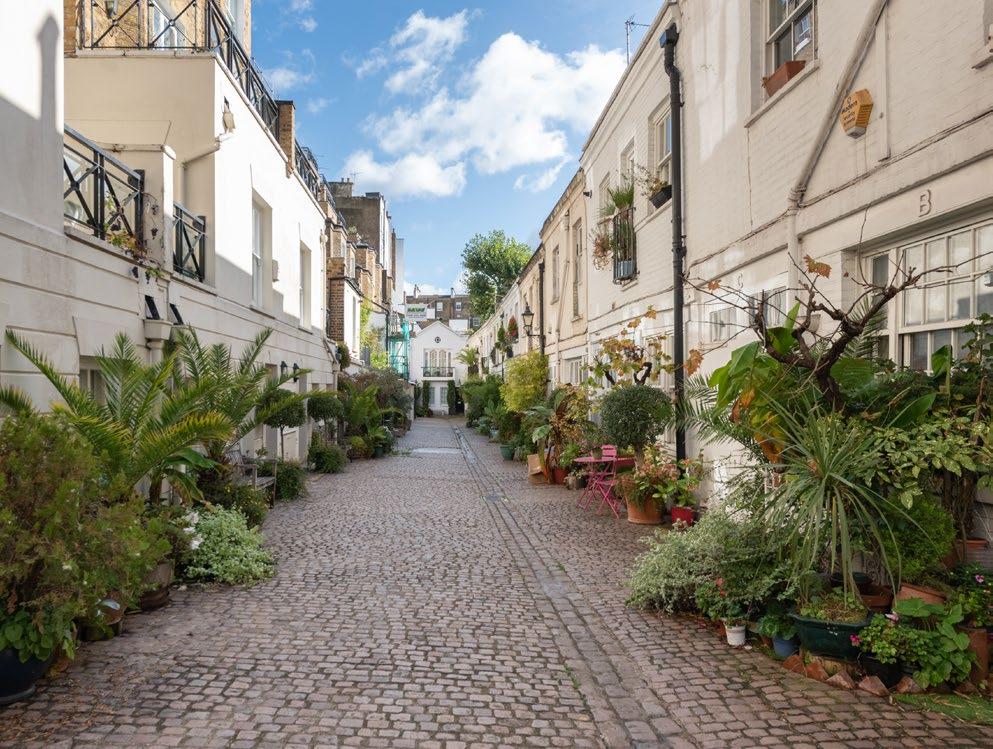
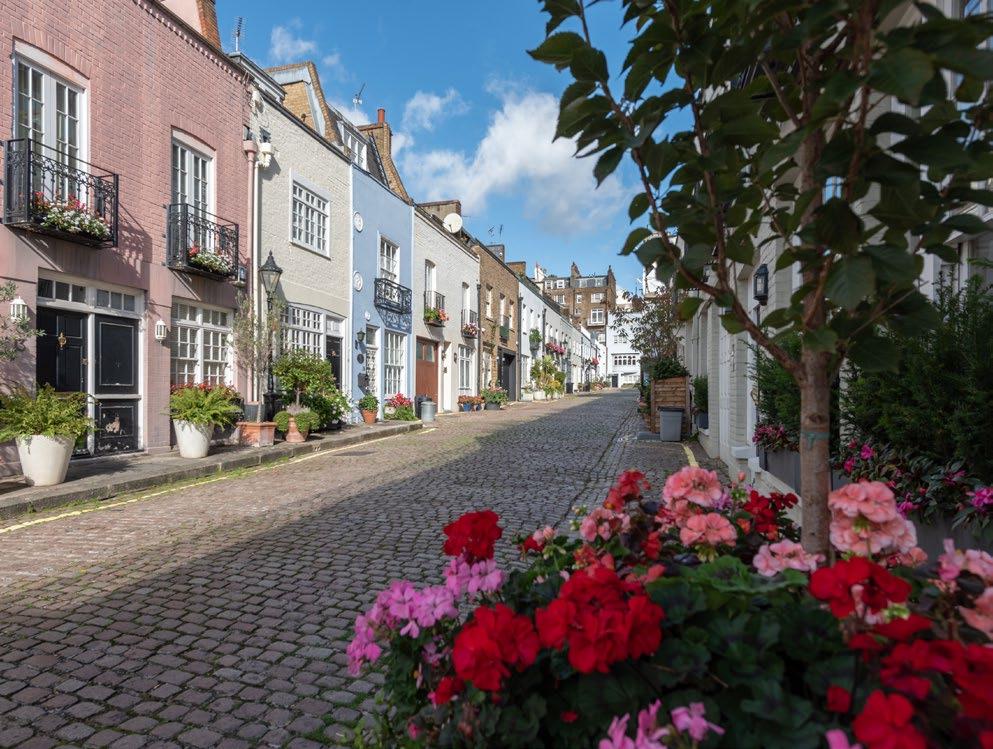
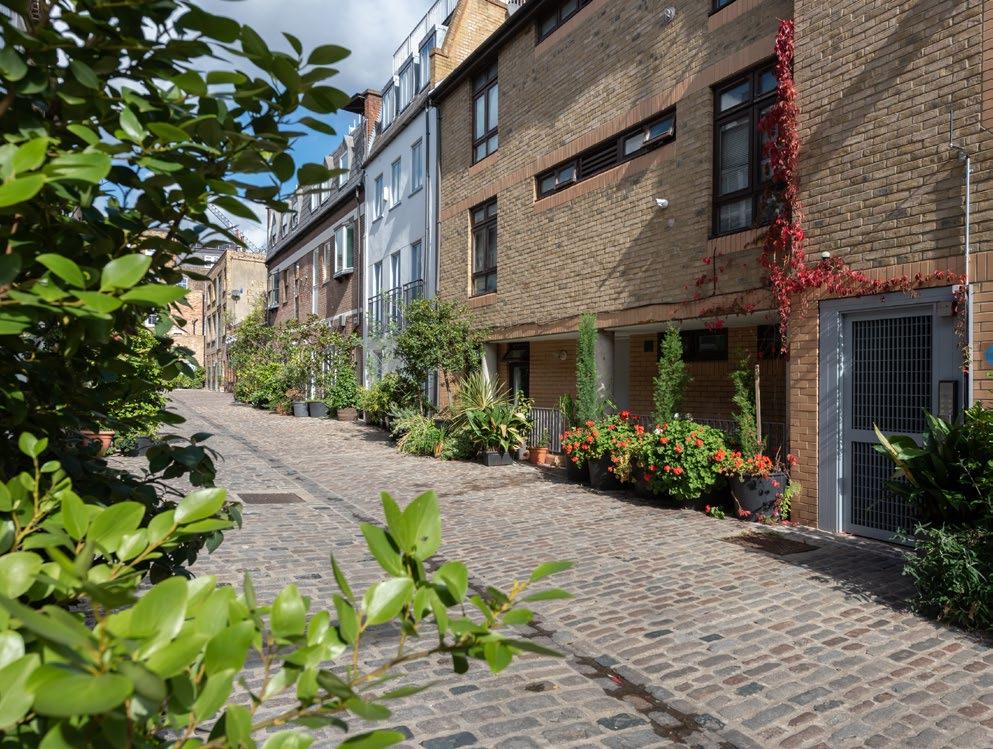
Many residents entered this year, and impressed with their green fingered creativity, enthusiasm and love of gardening.
The transformation that happens in these friendly mews havens always leaves a lasting impression and brings a smile to many faces.
So the moment you’ve all been waiting for, and in no particular order, it gives us great pleasure to announce our shortlist of winners.
The overall winner will be announced in the winter edition of Mews News, on our website and social media:
We reach over 11,000 physical mews addresses and over 6,000 mews enthusiasts online with digital and print copies of Mews News.
Showcase your property here to reach an audience that trusts our expertise in all things mews.
Click below to book a valuation
020 7590 9955 www.lurotbrand.co.uk
